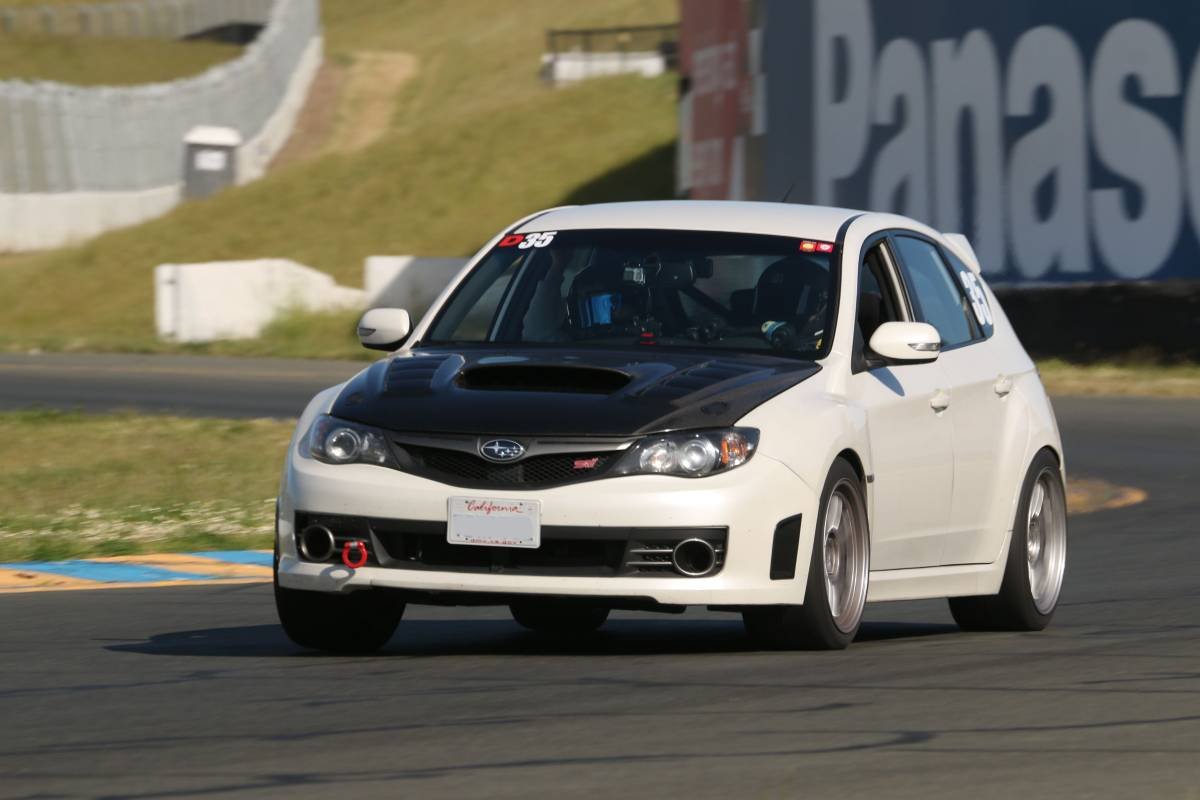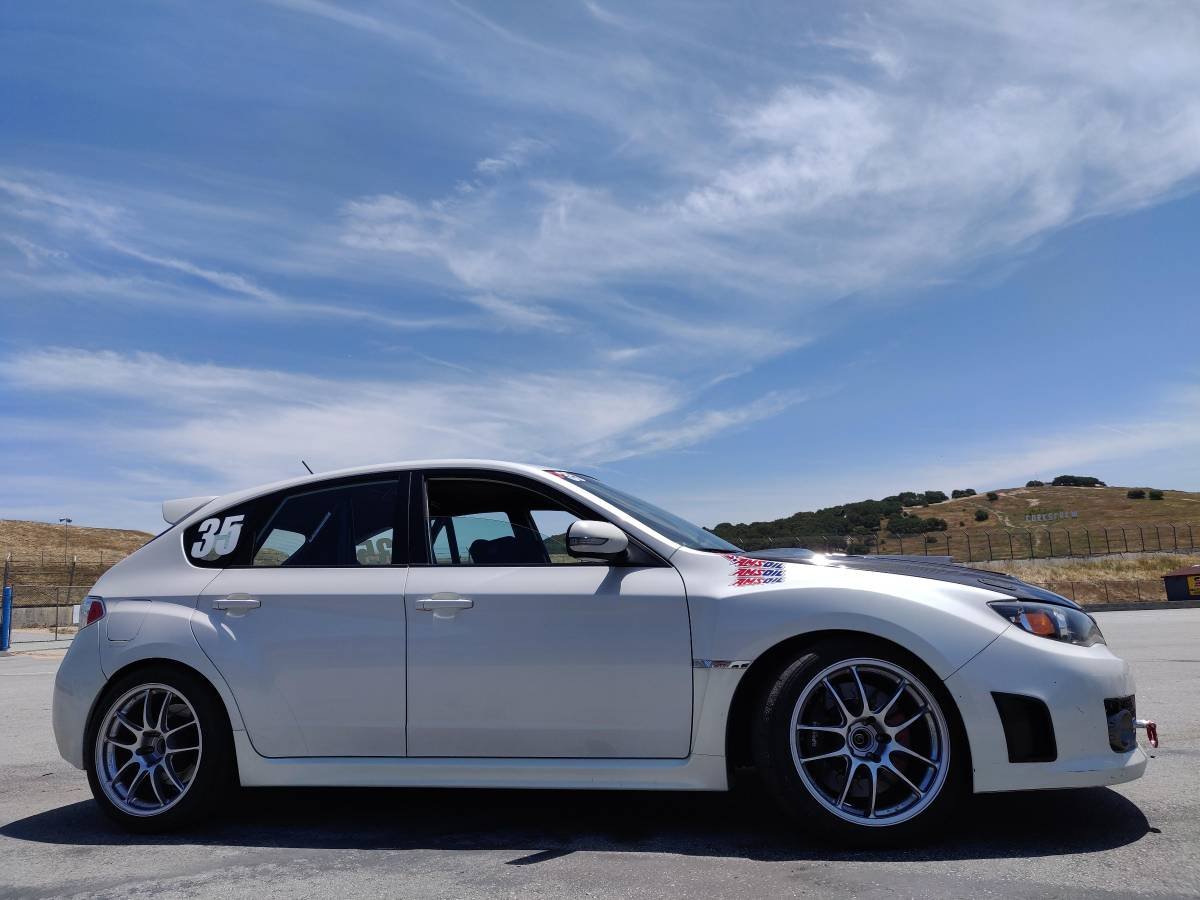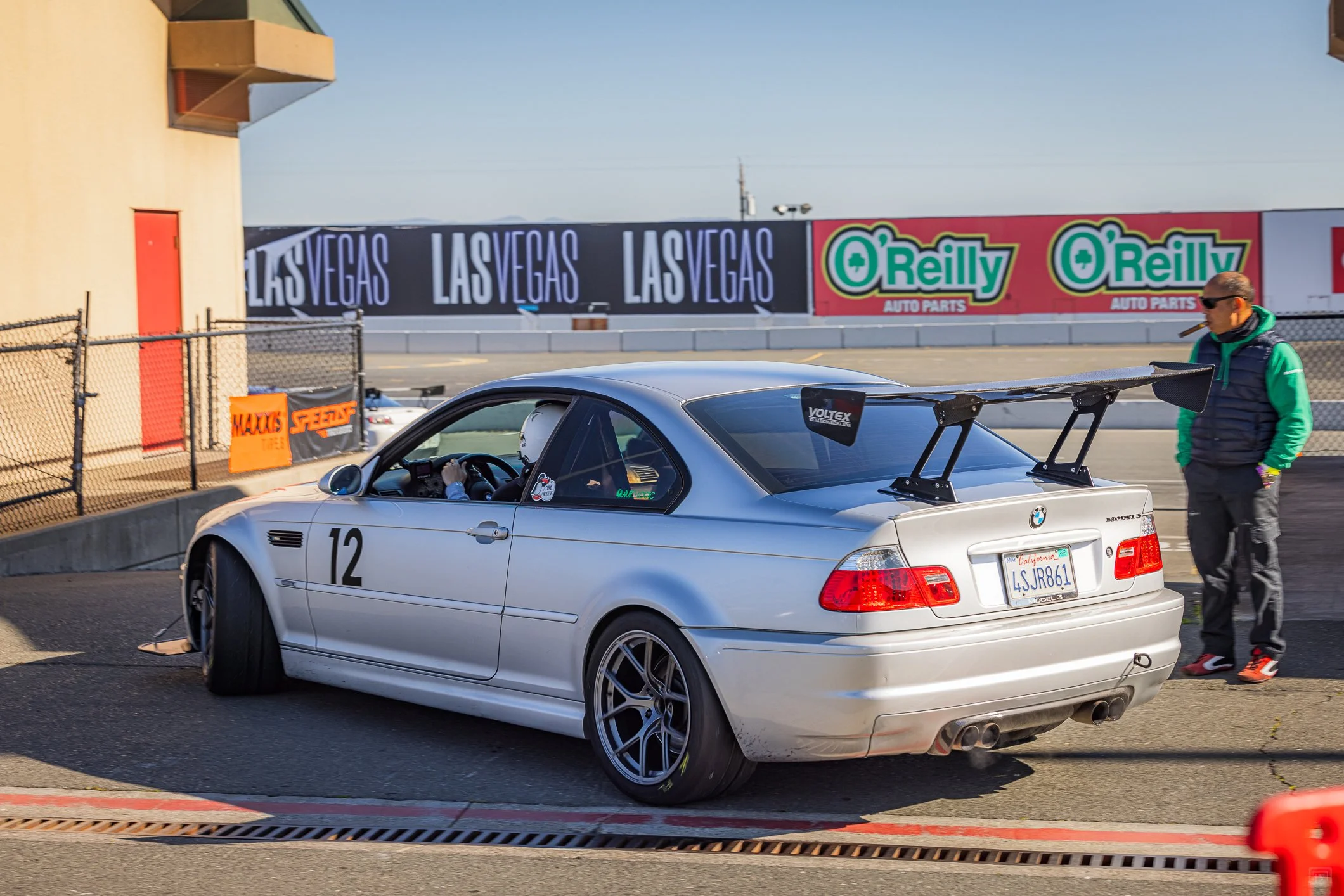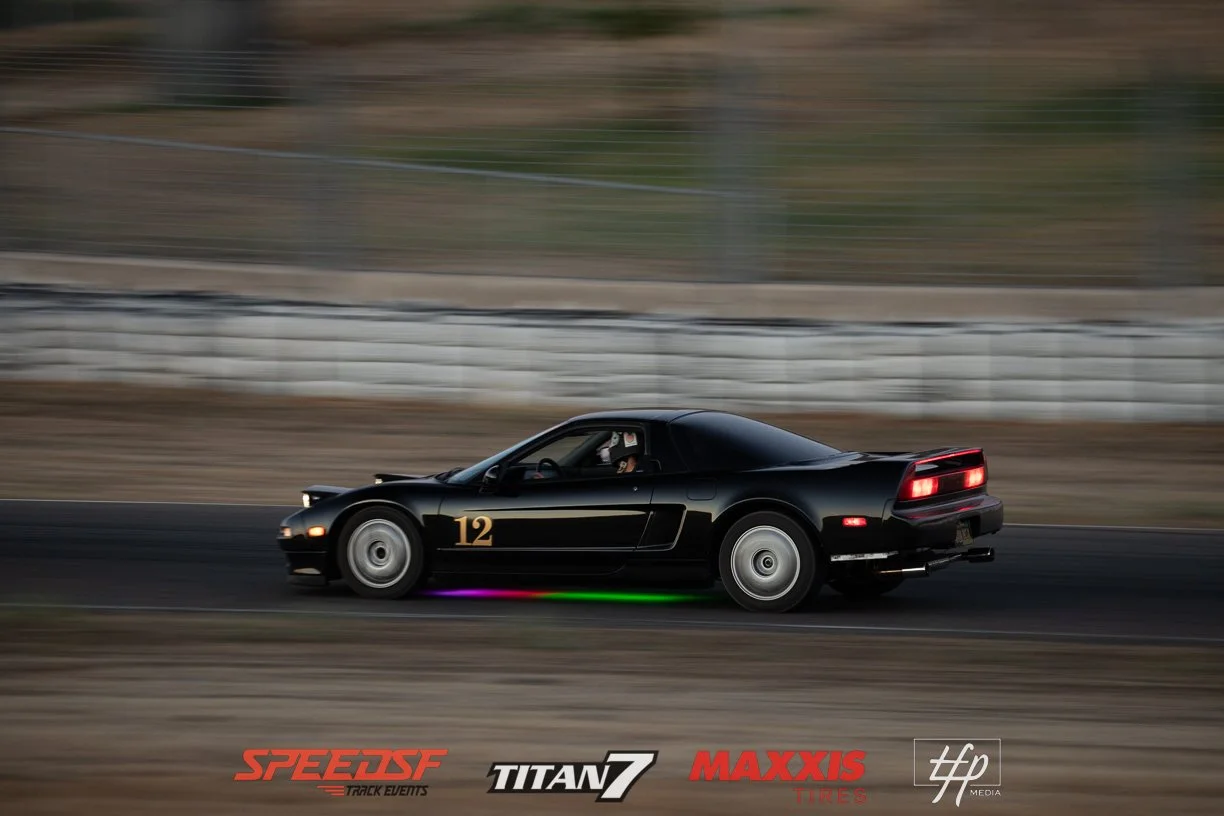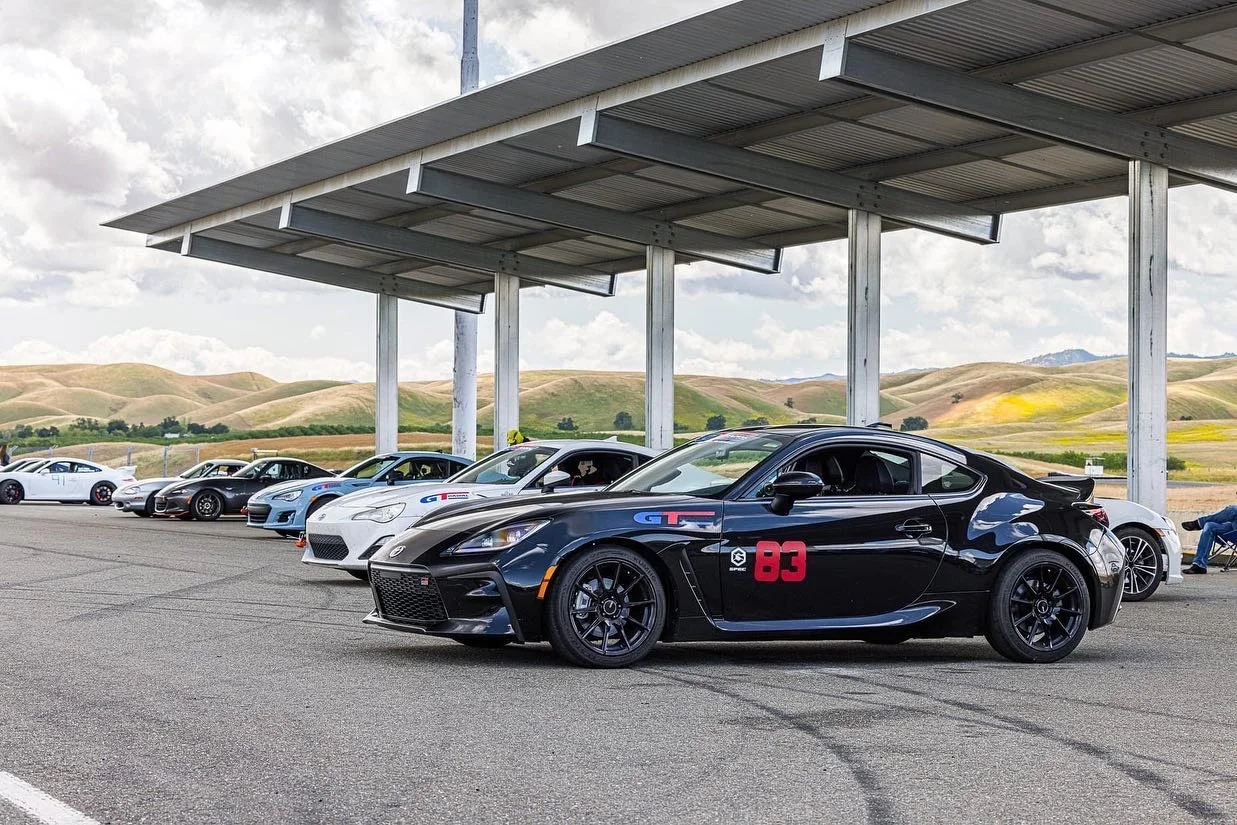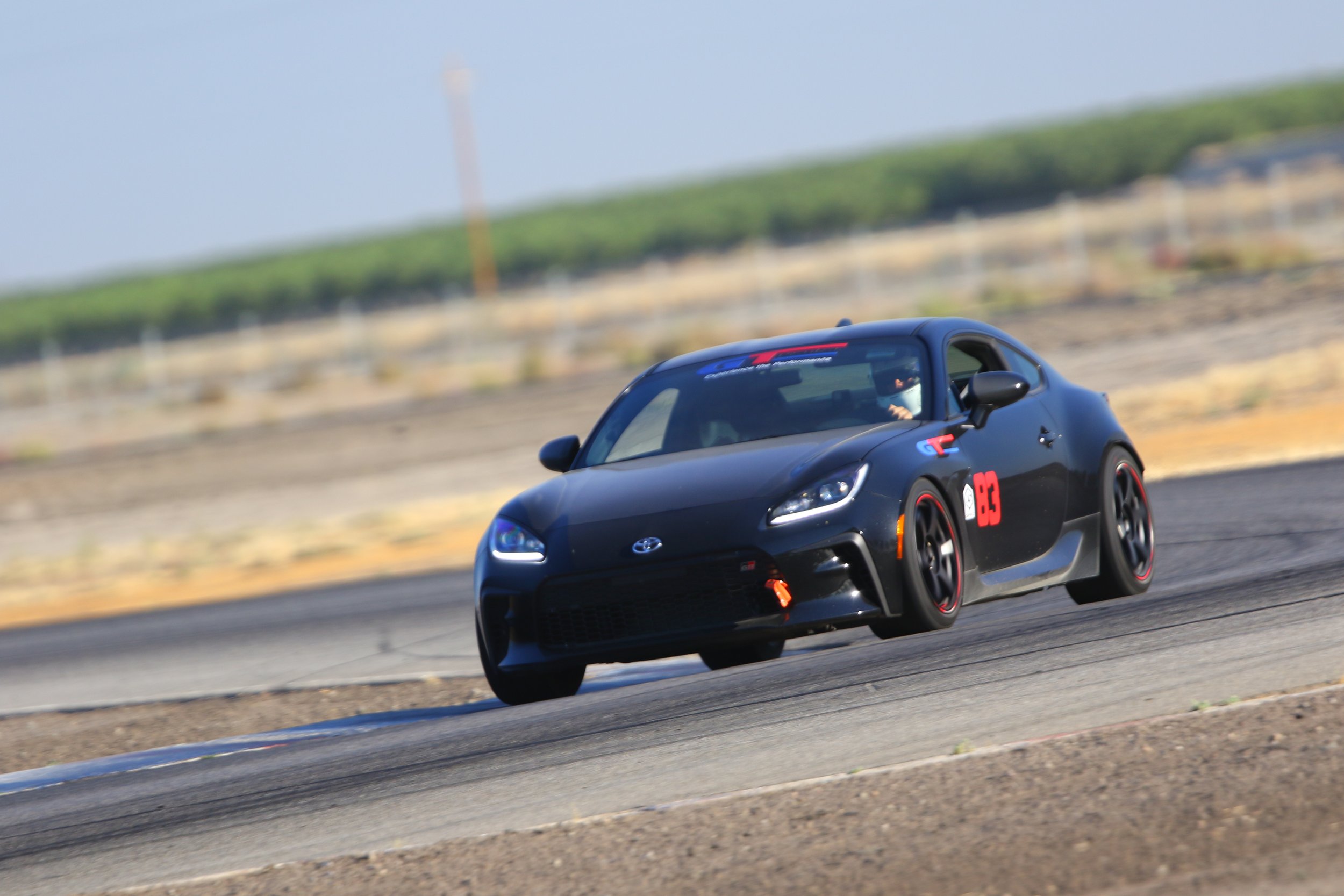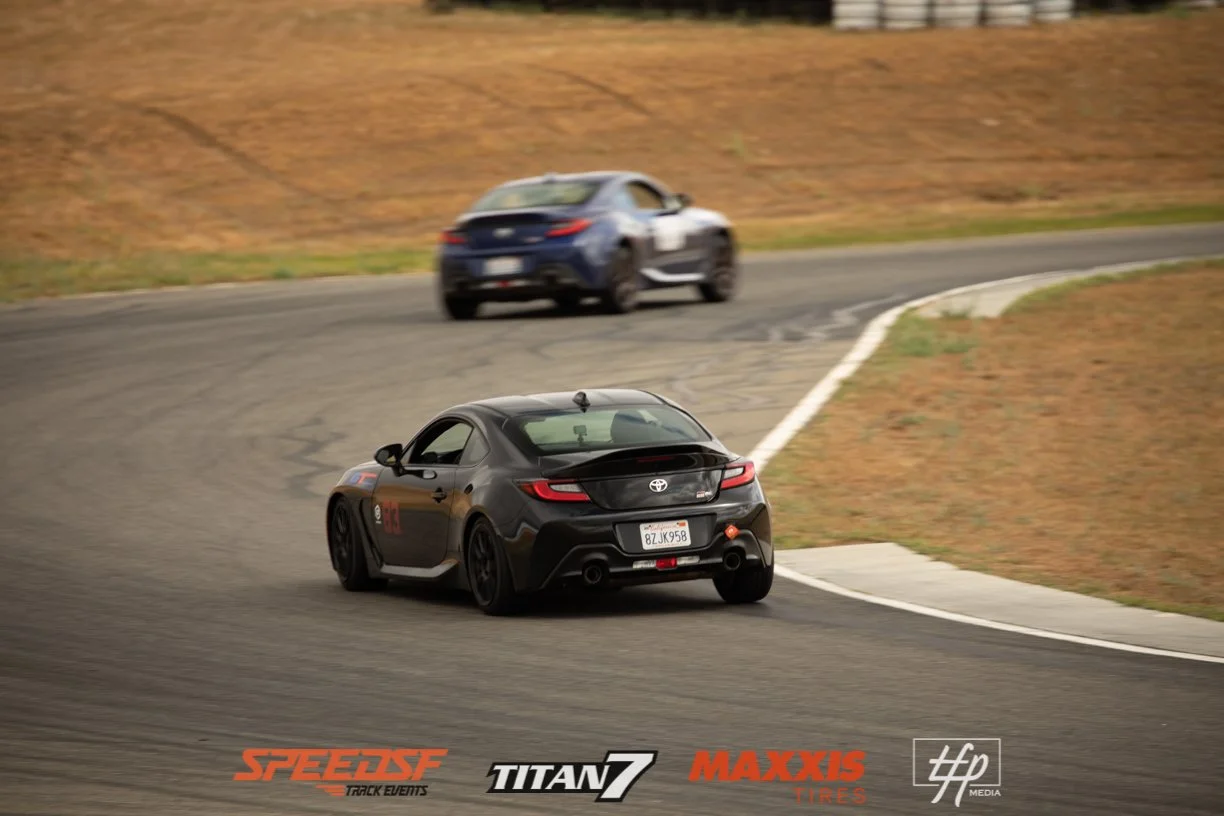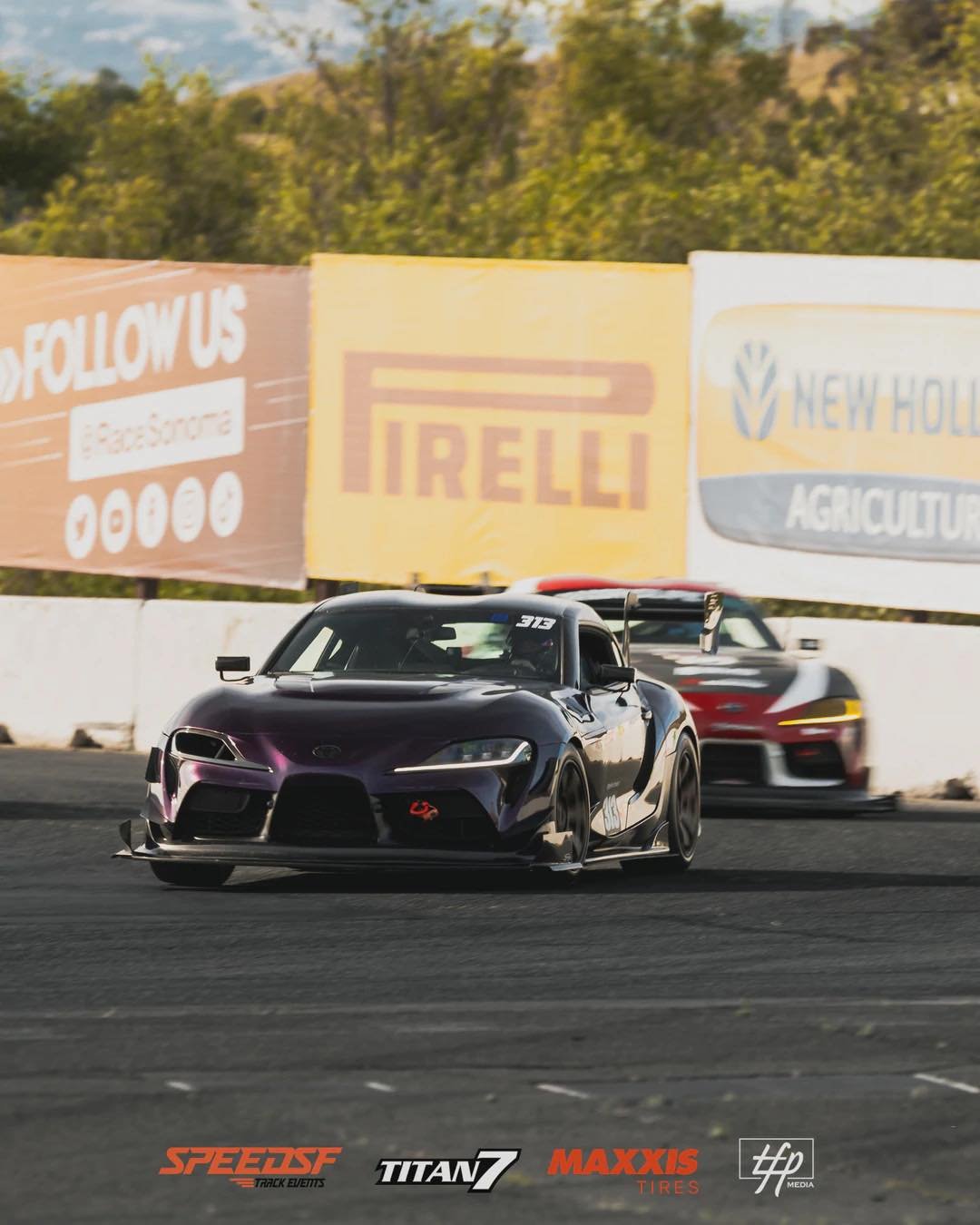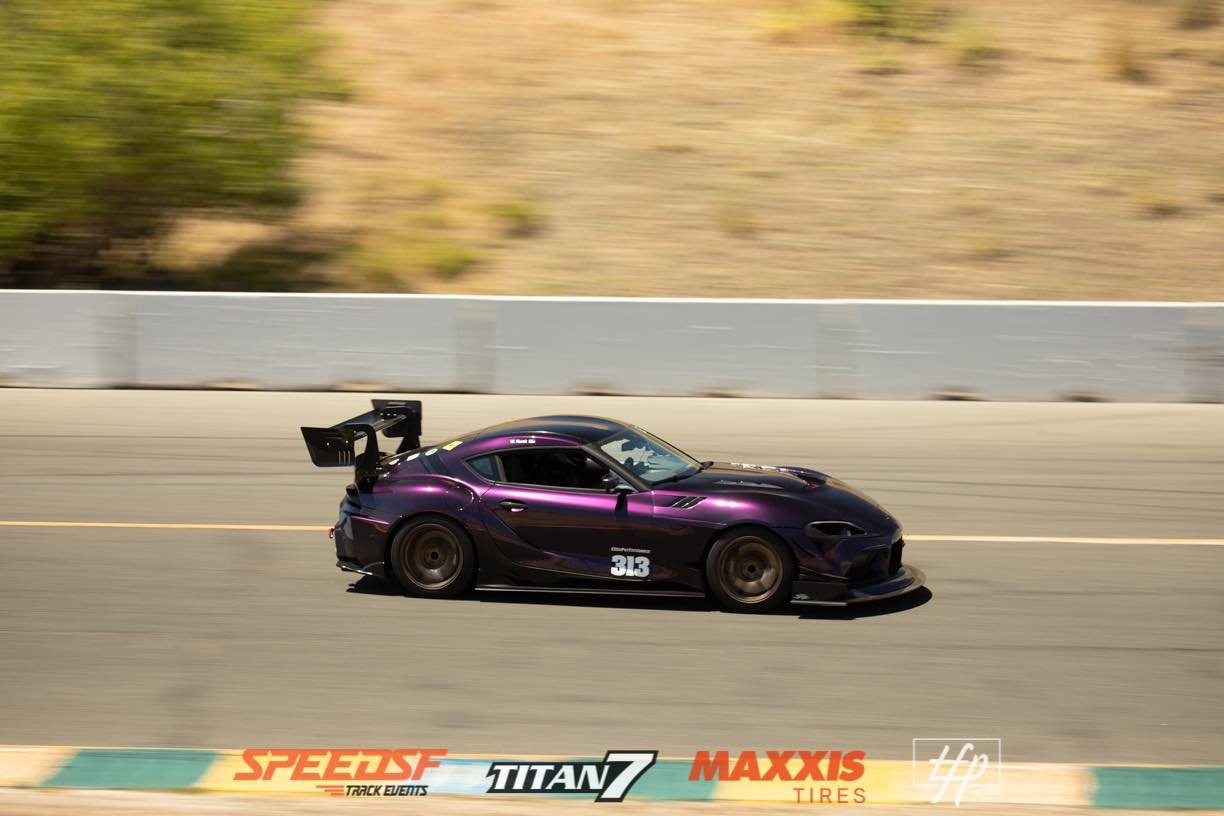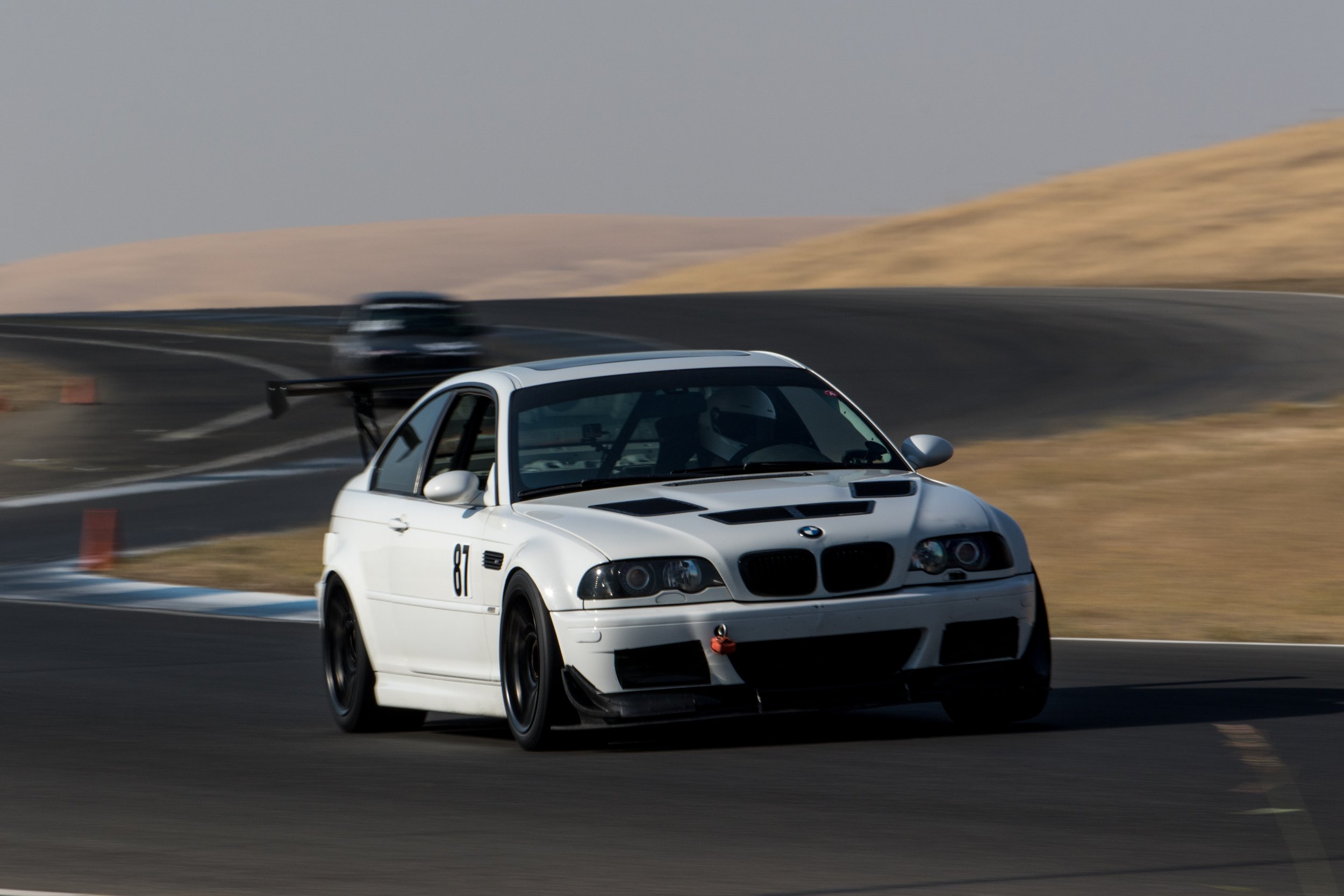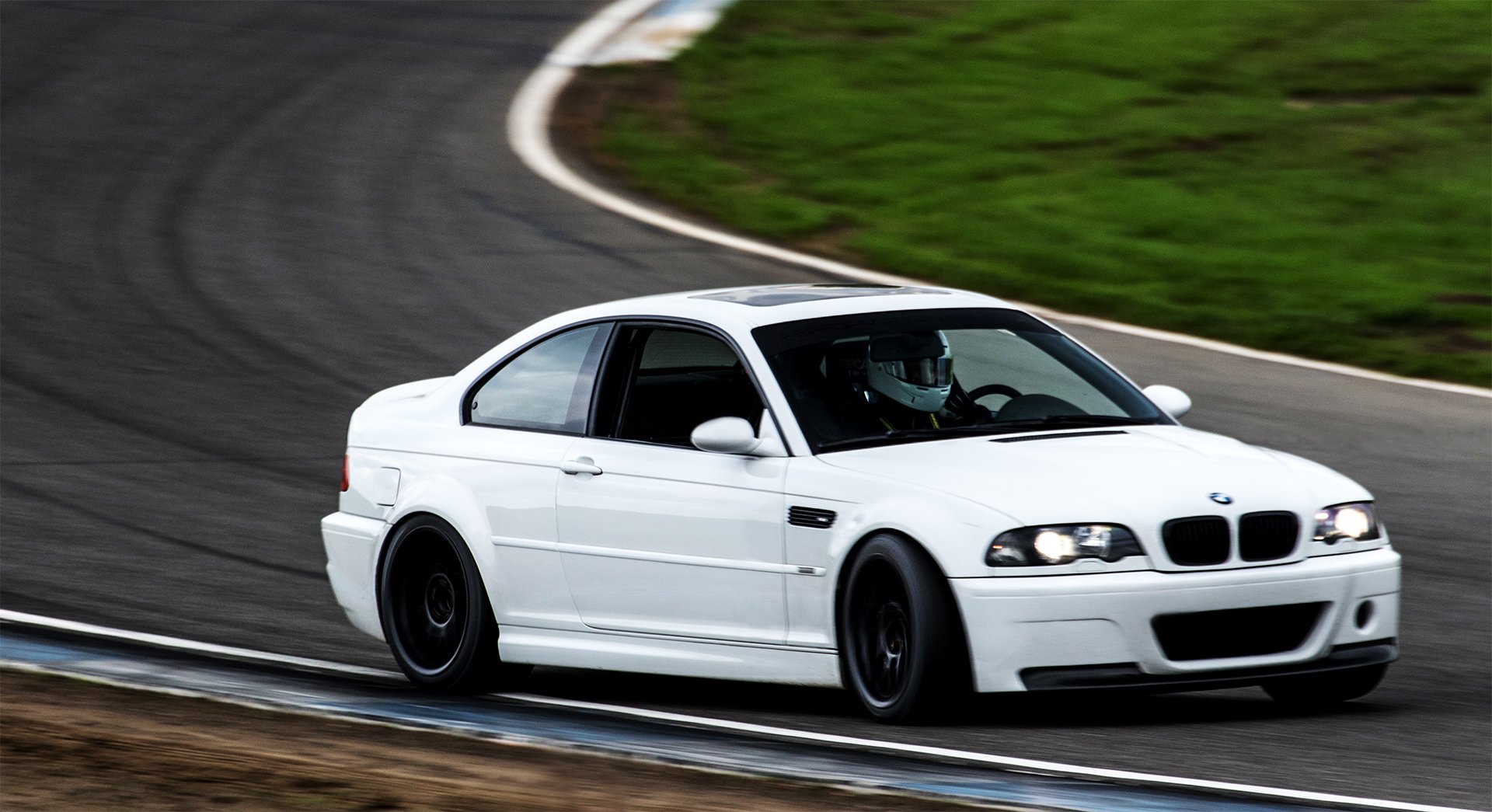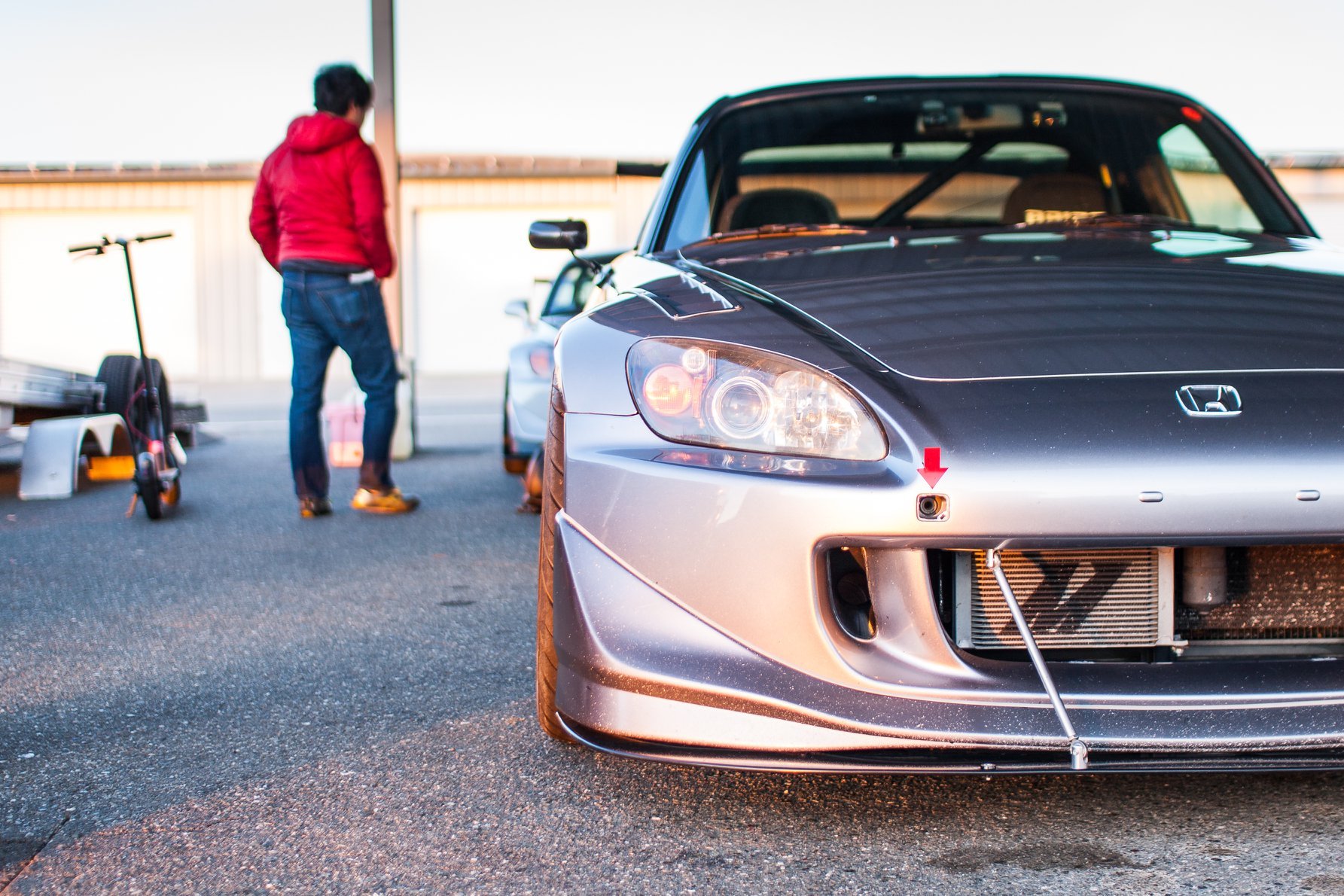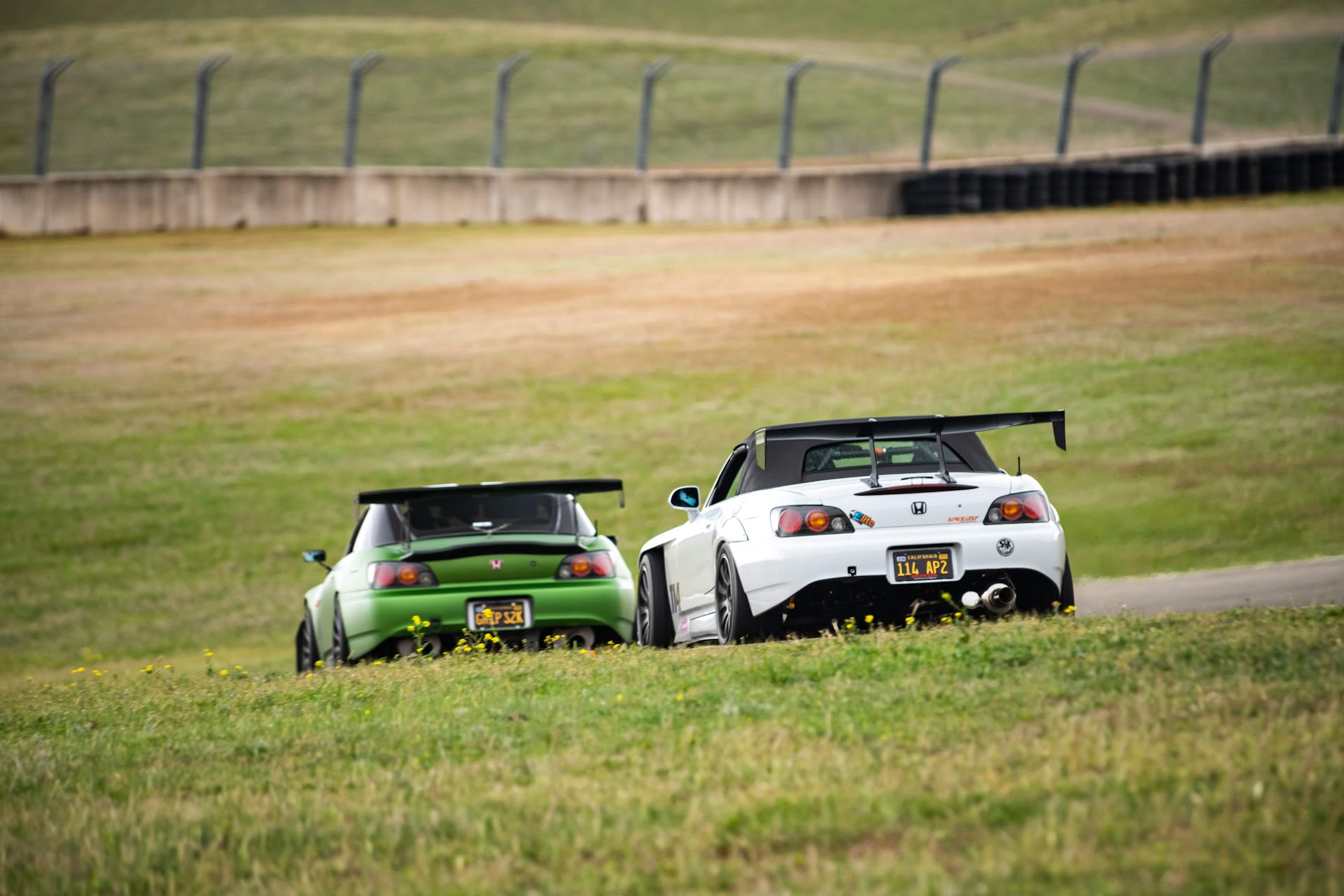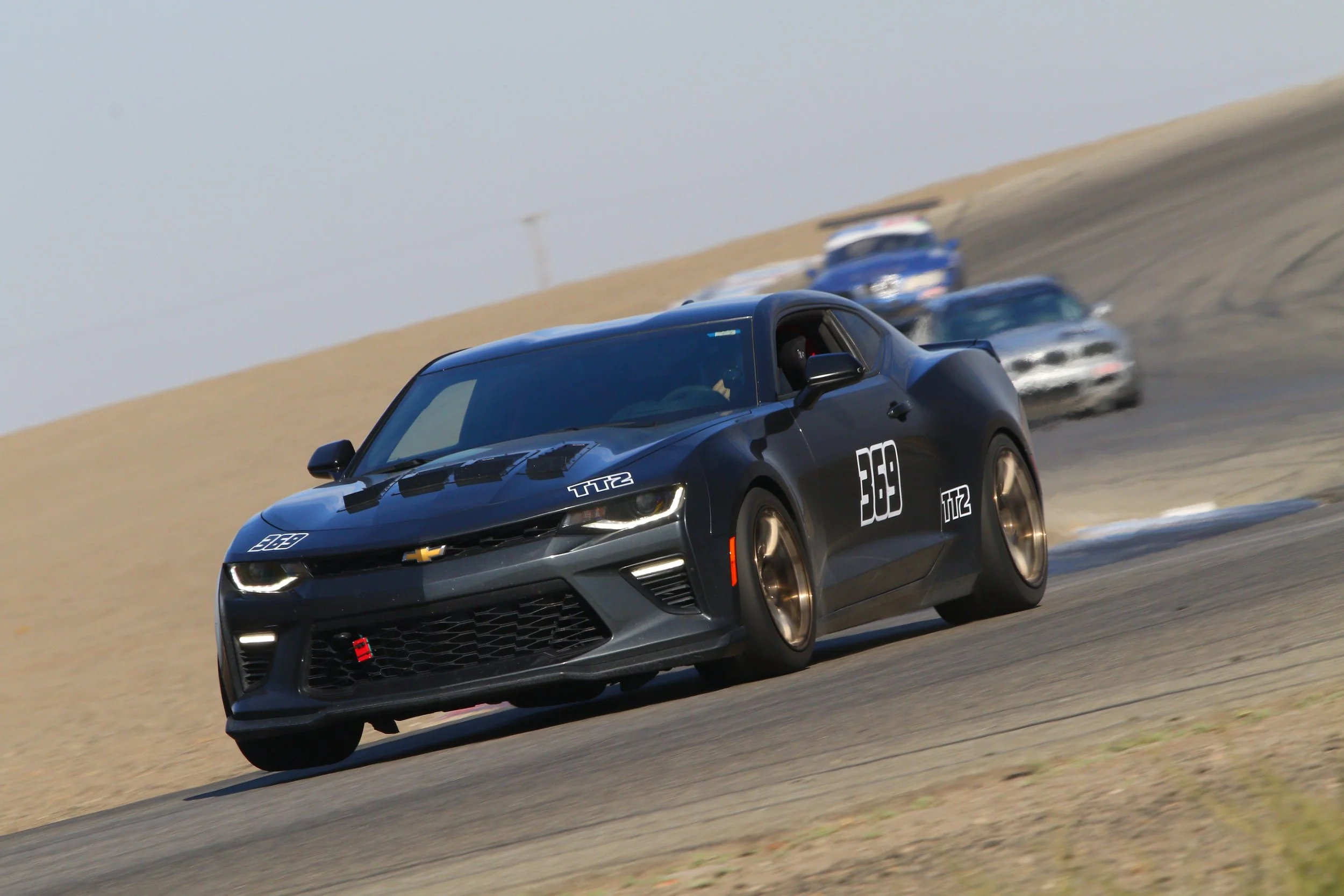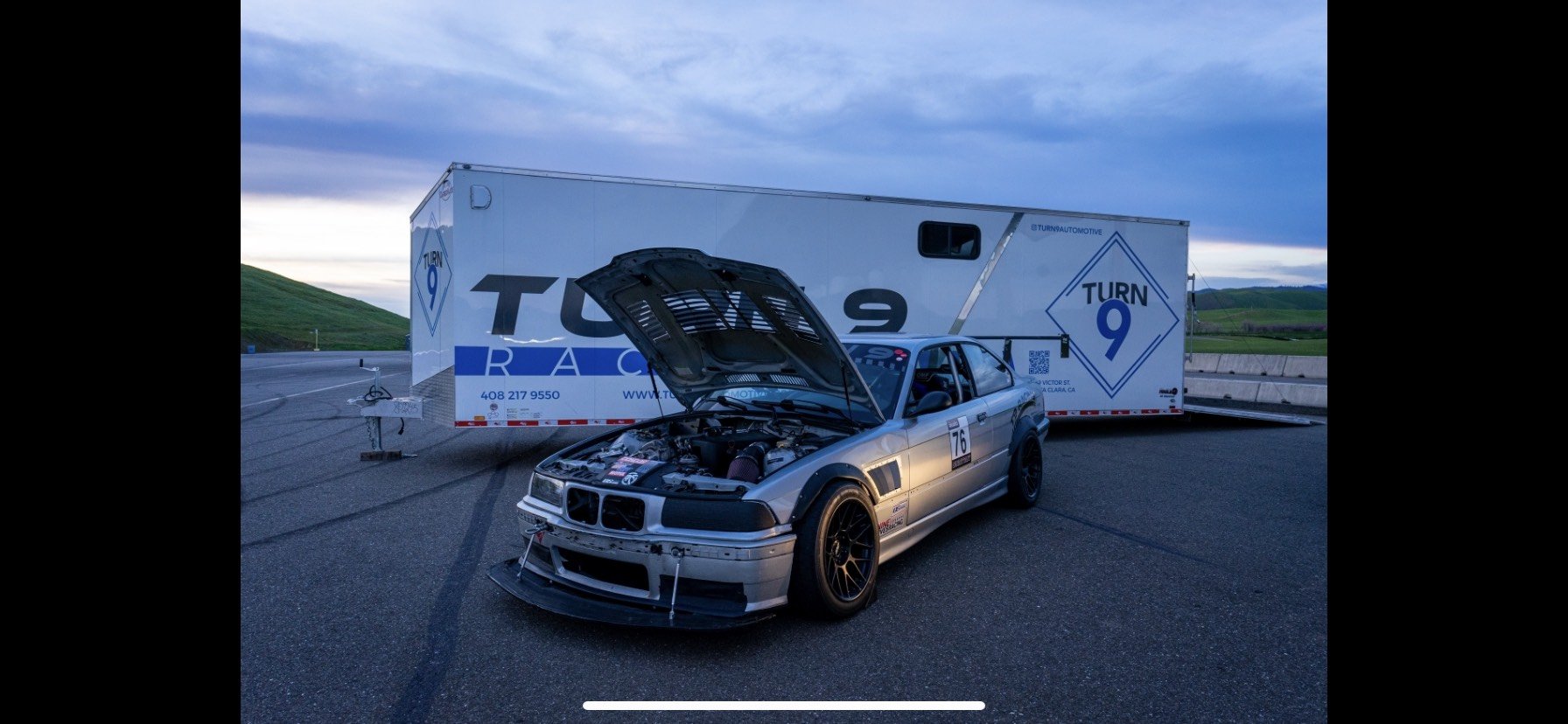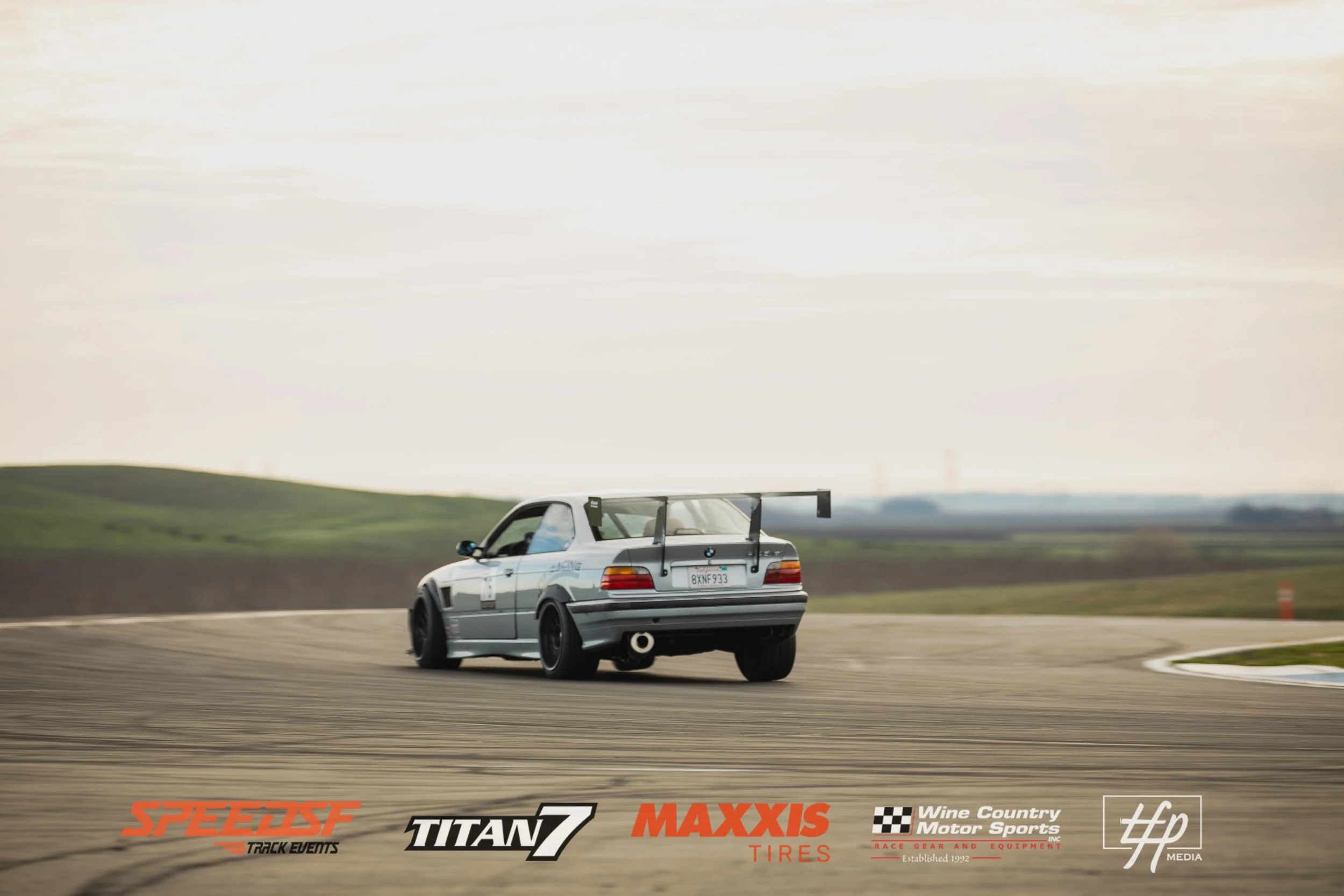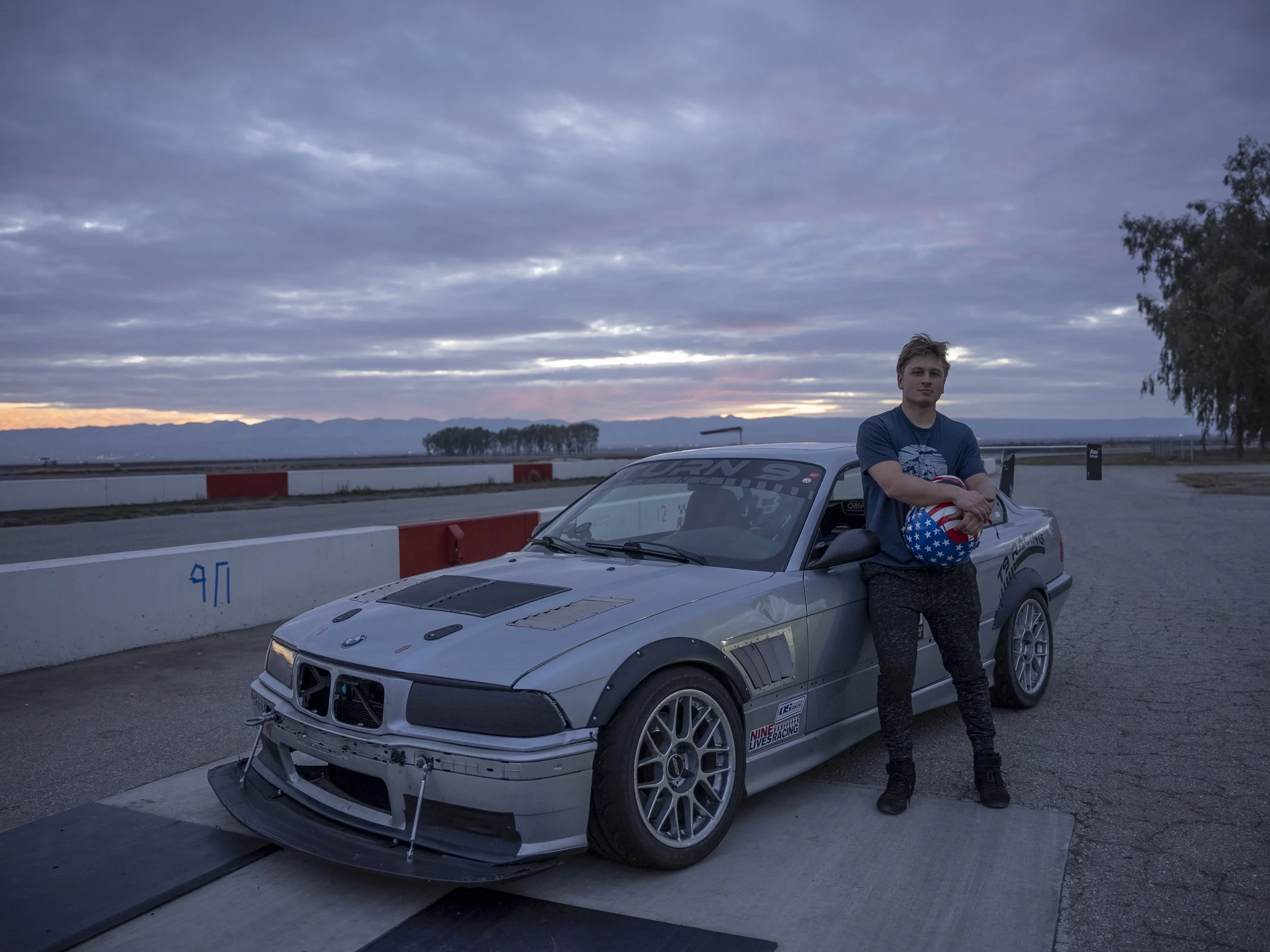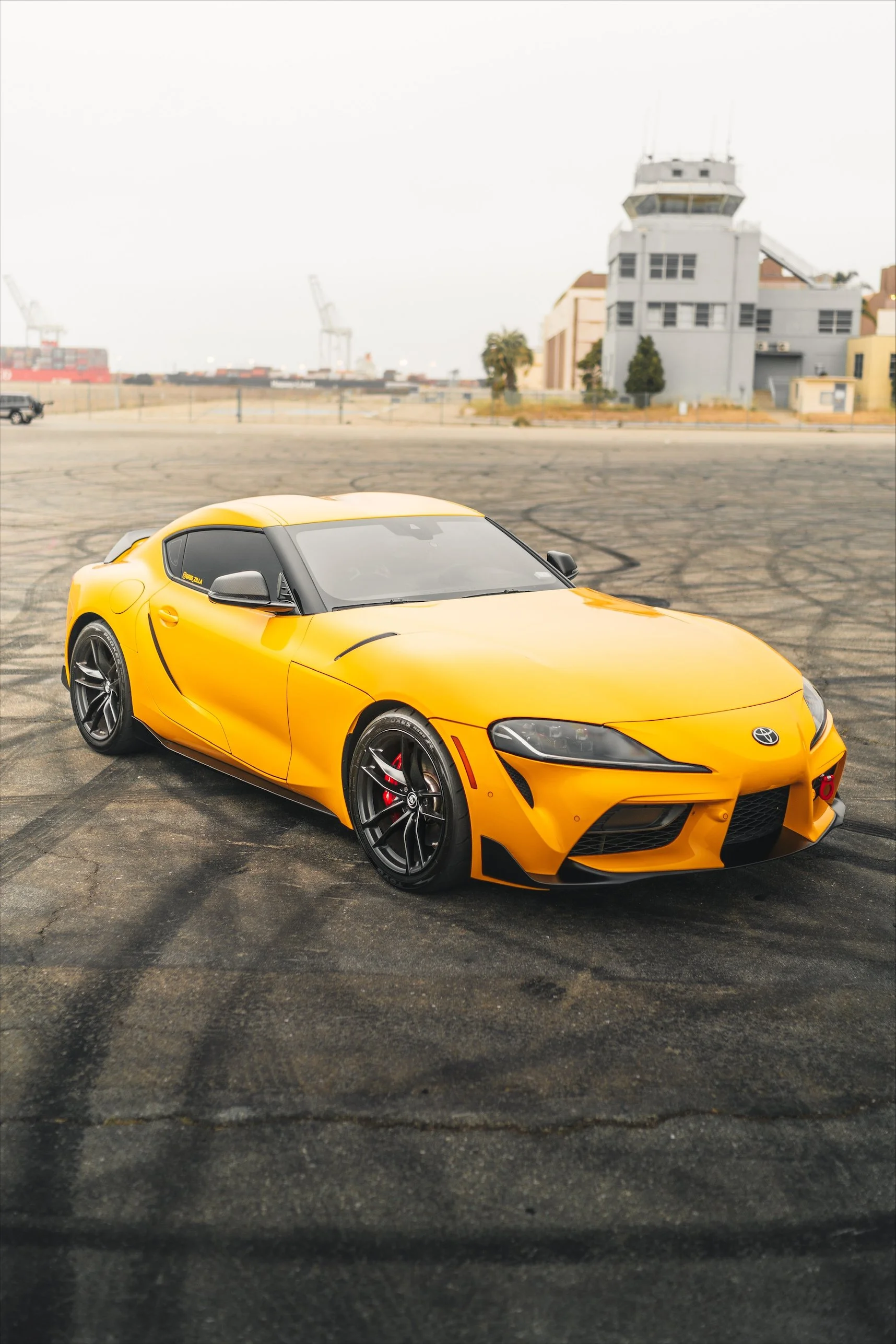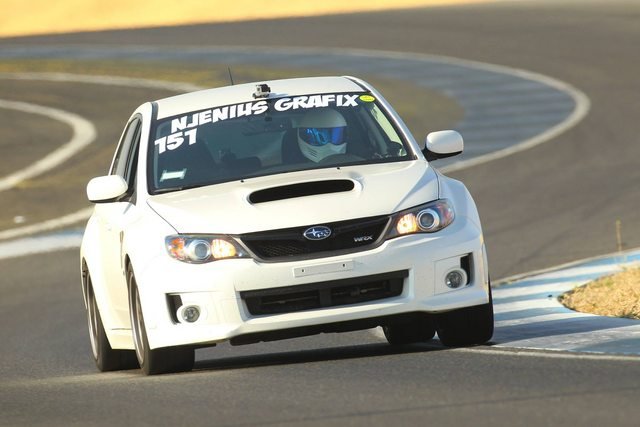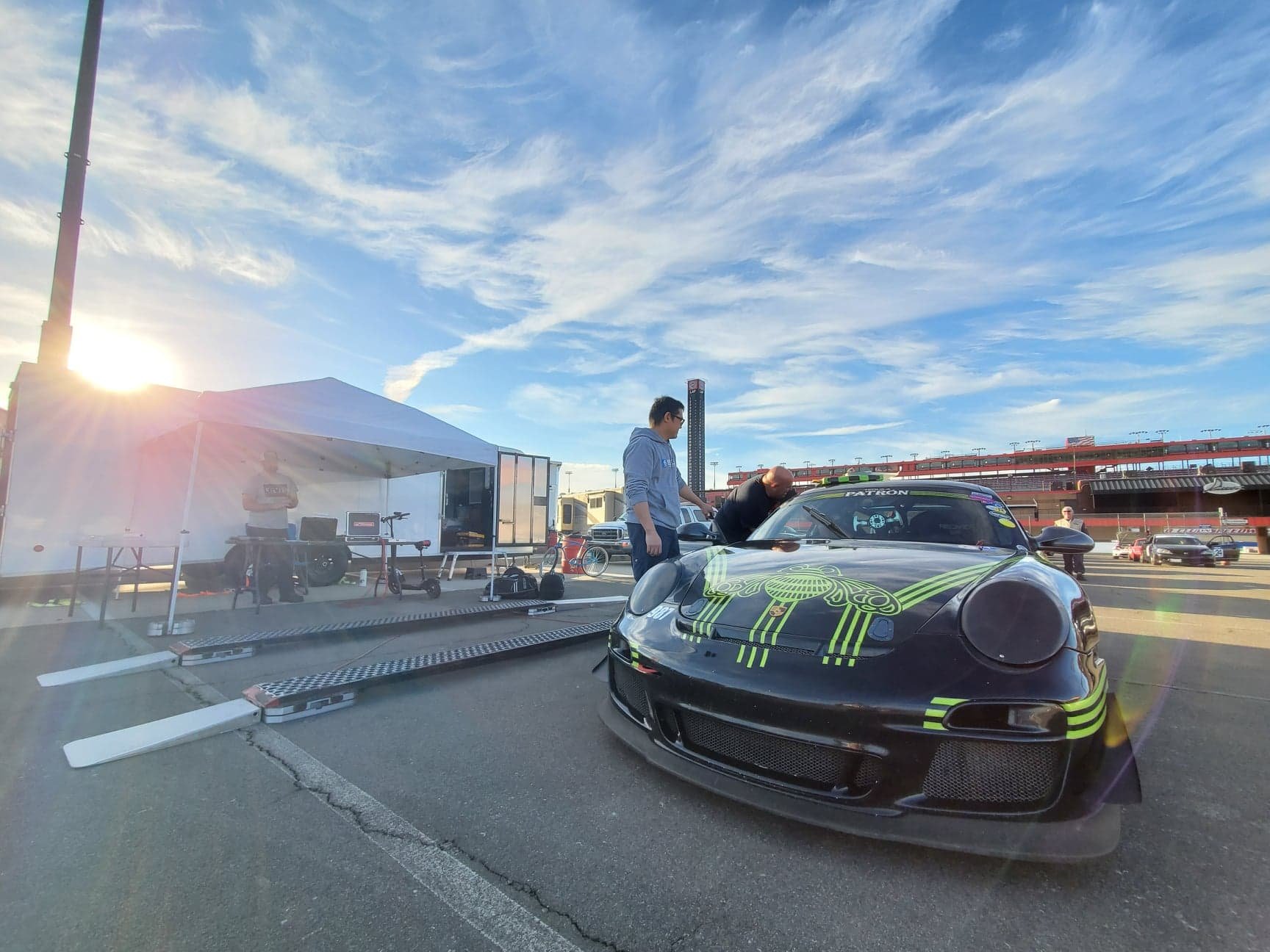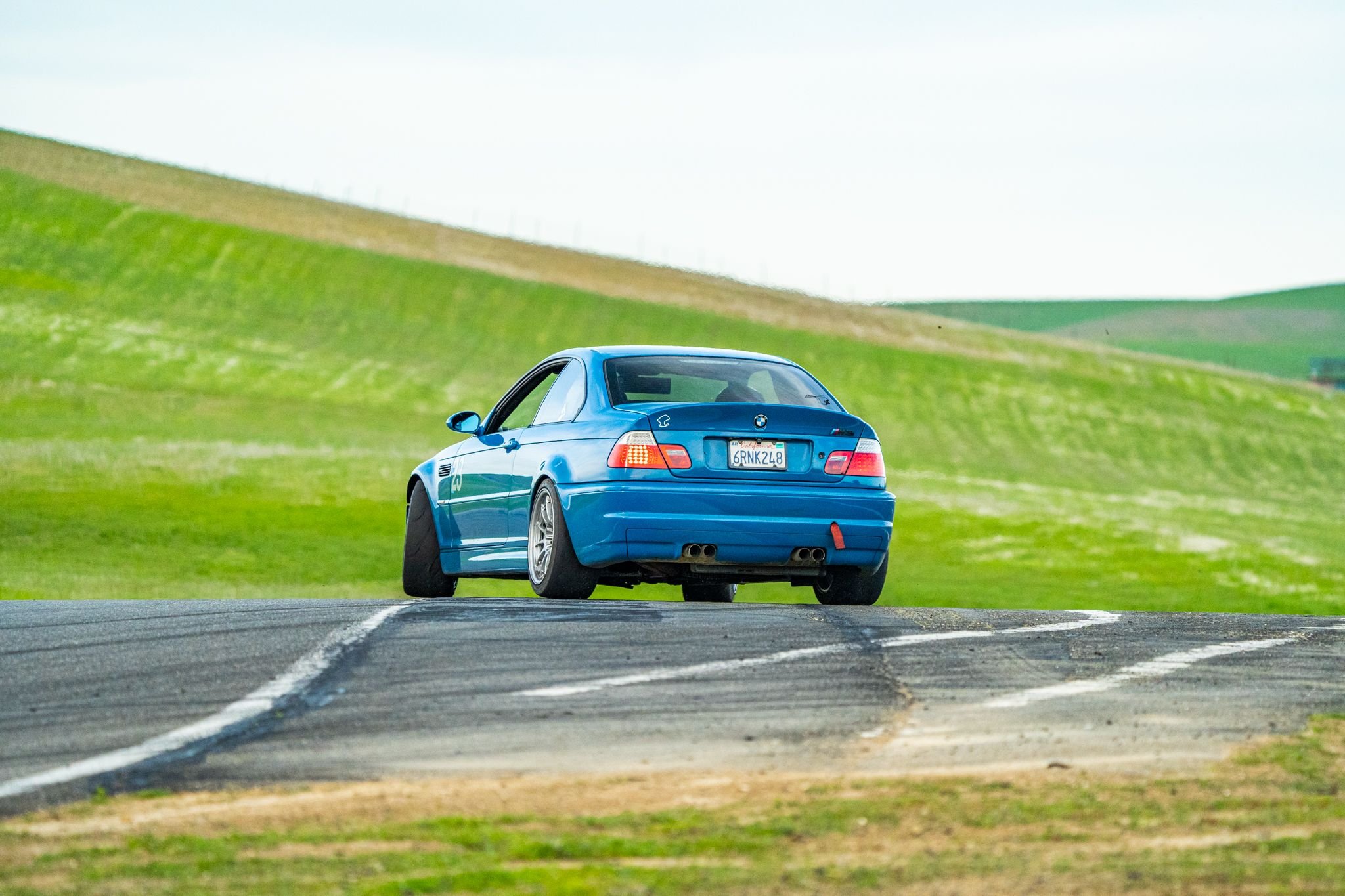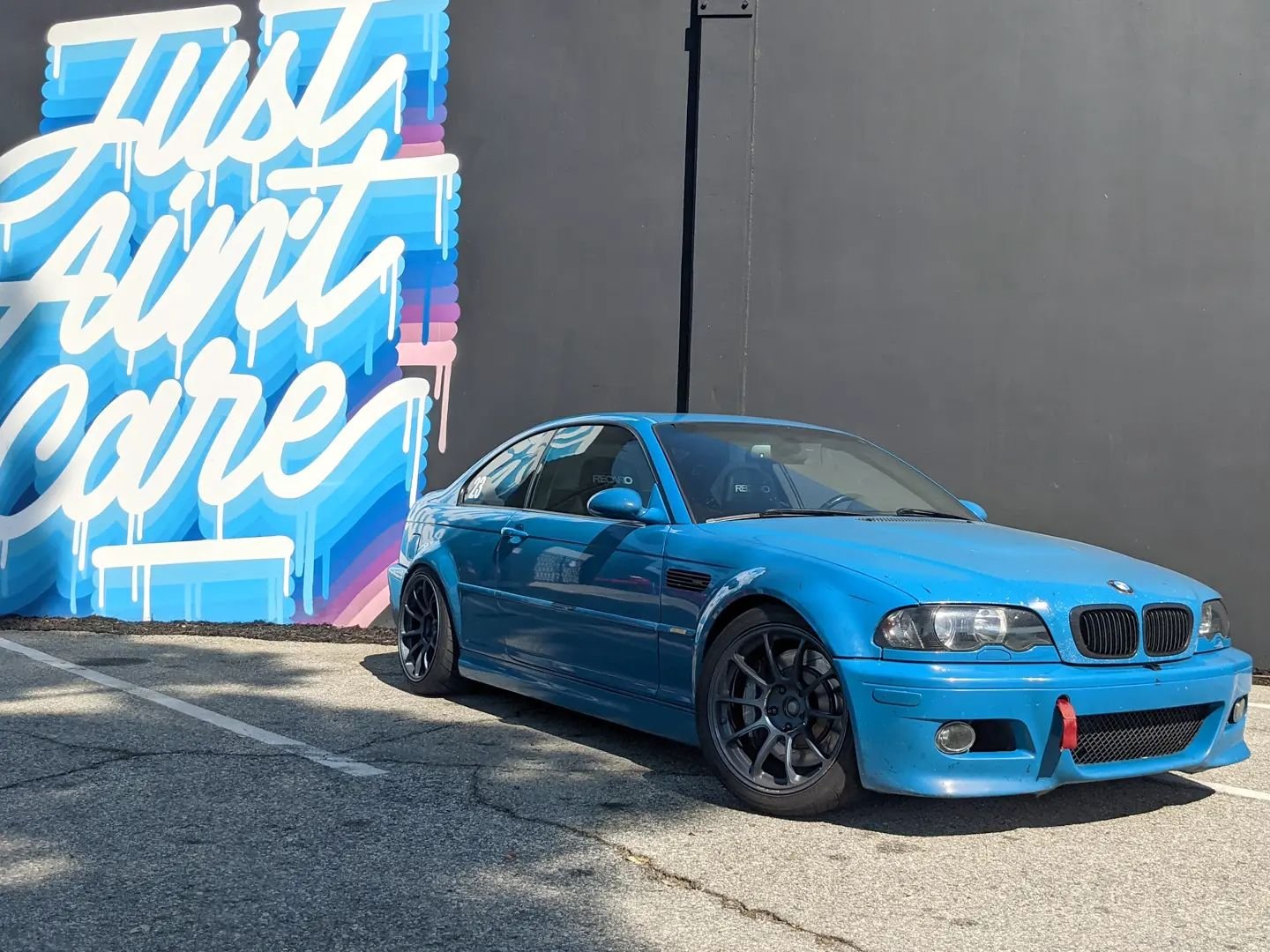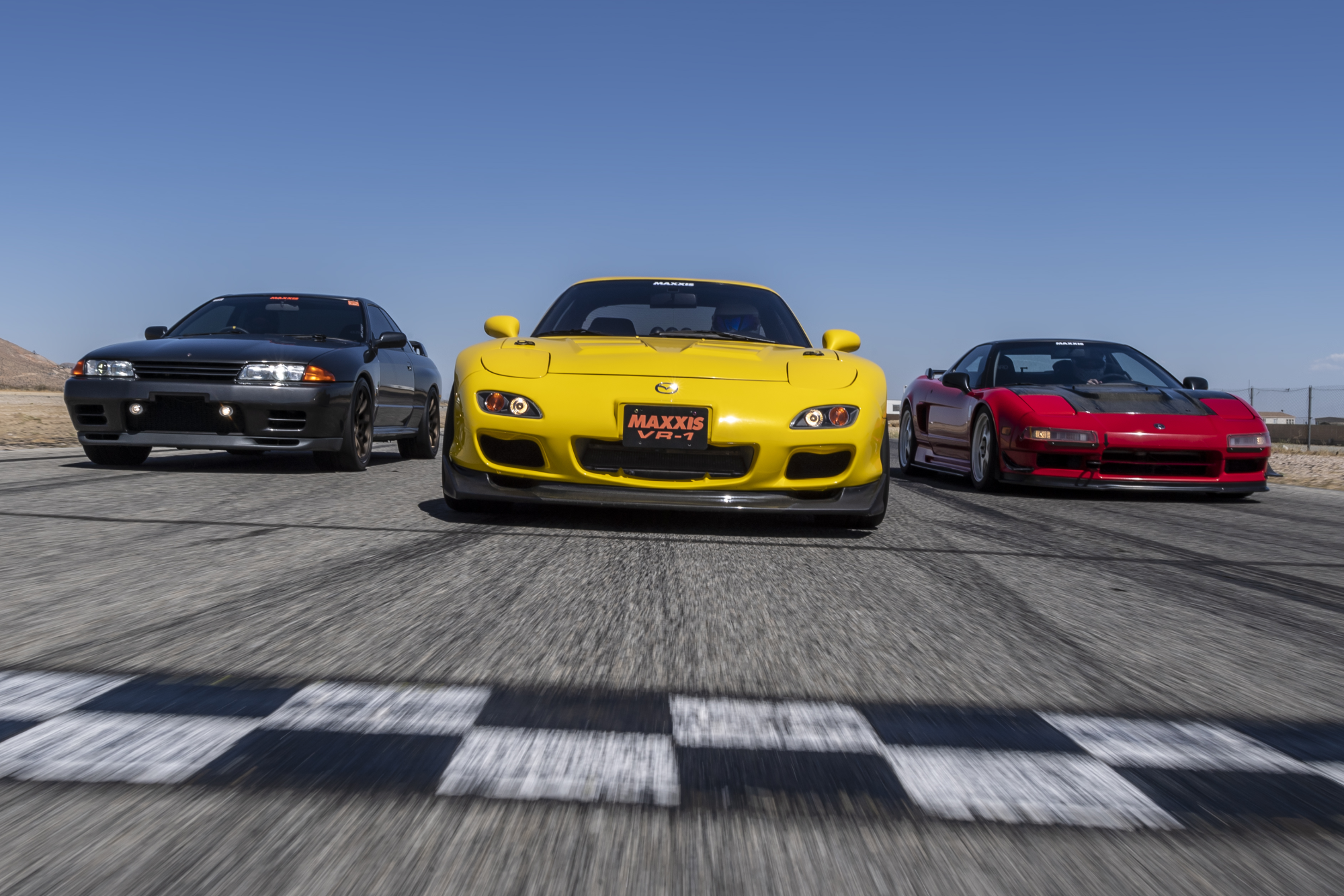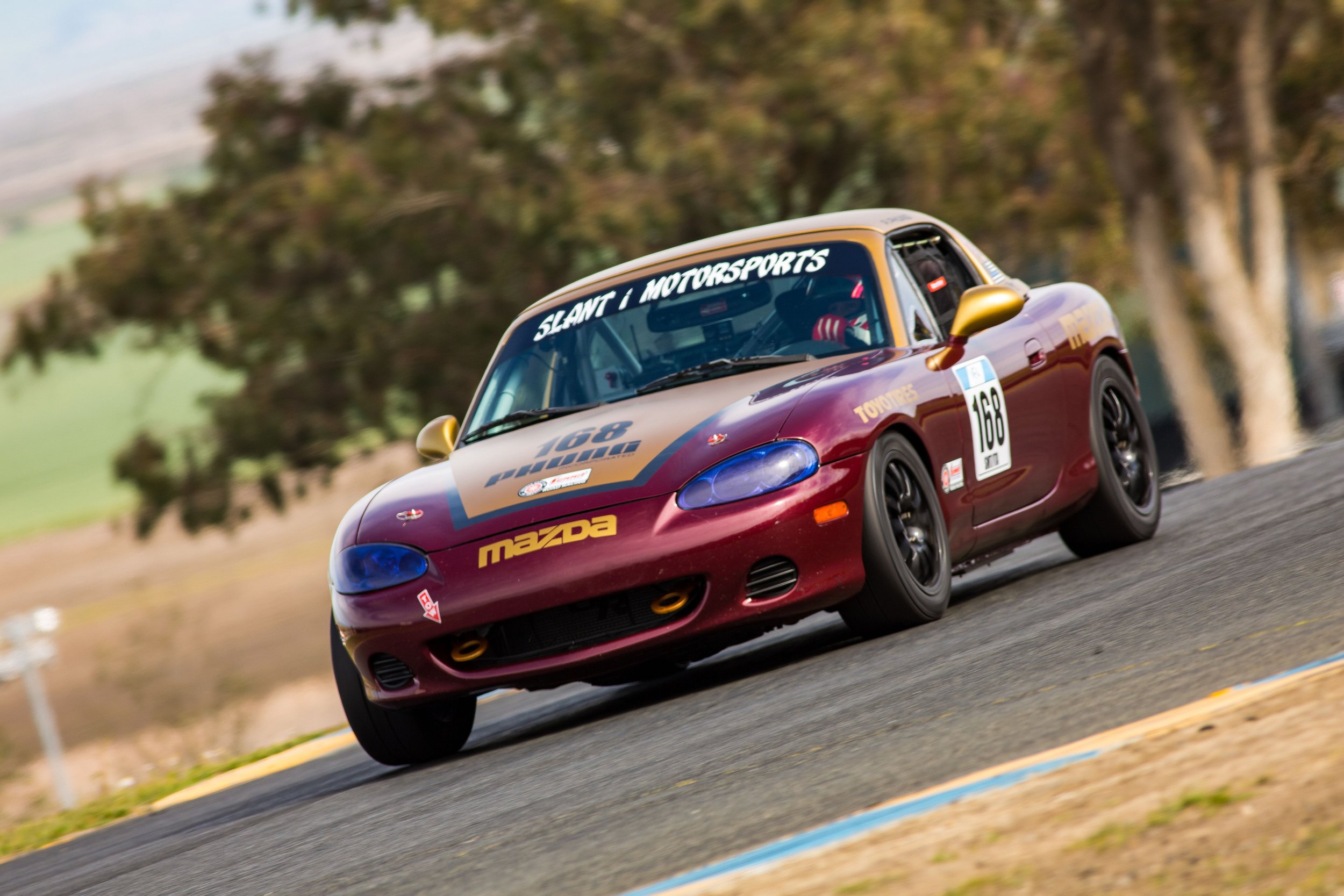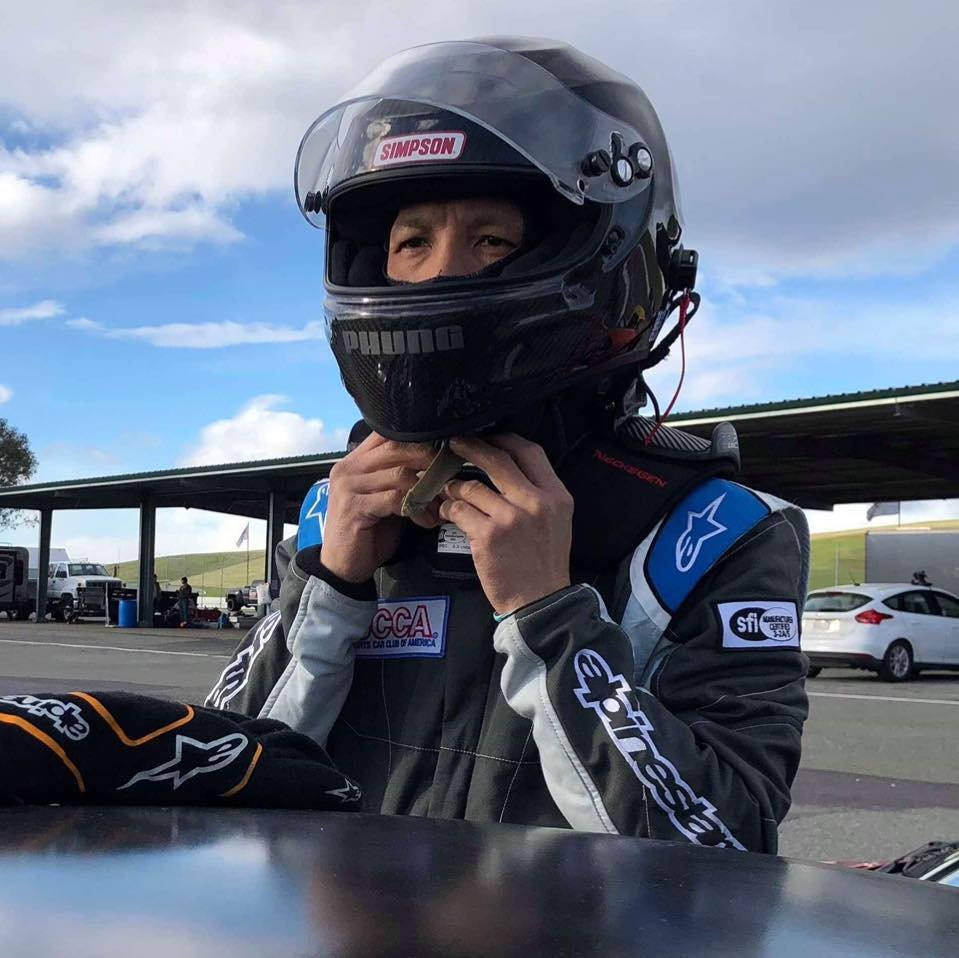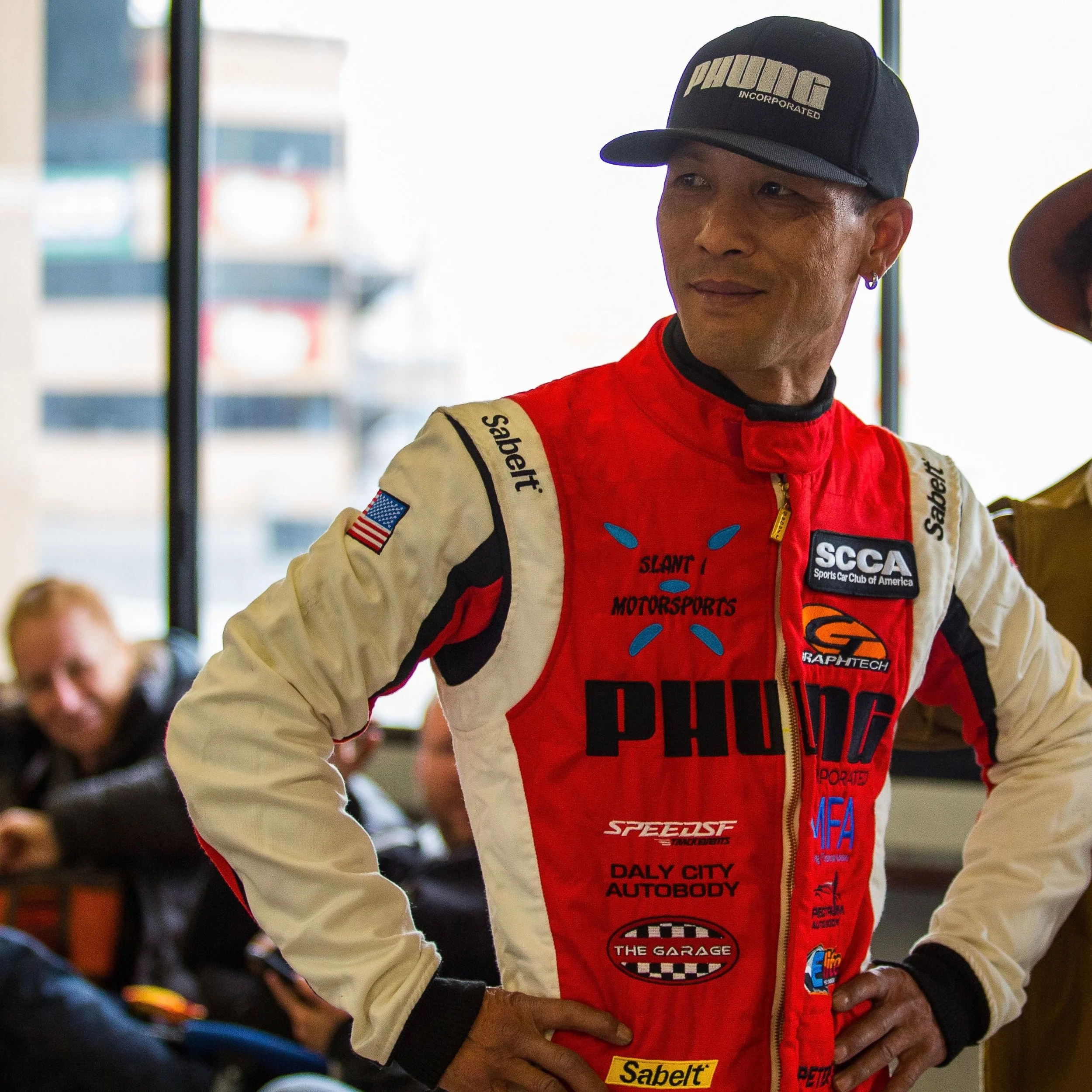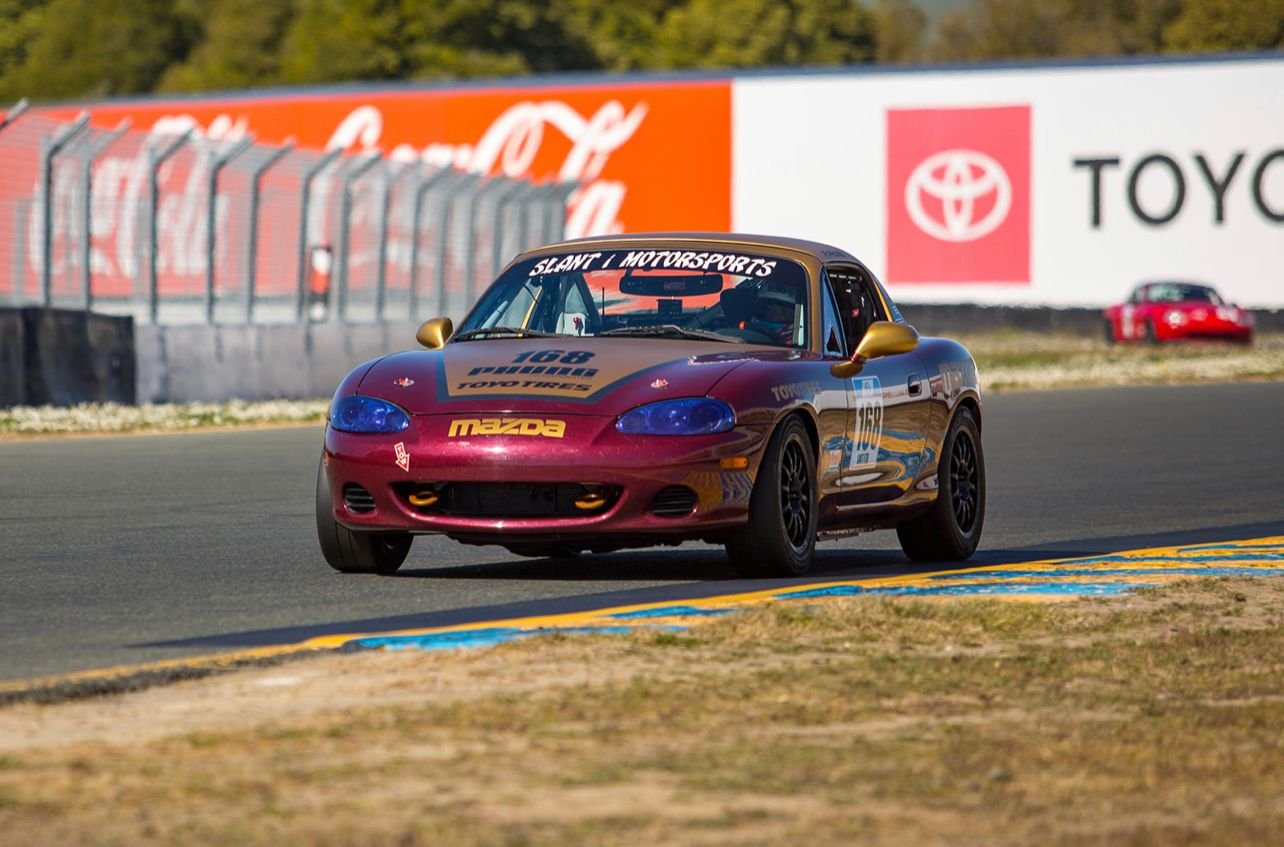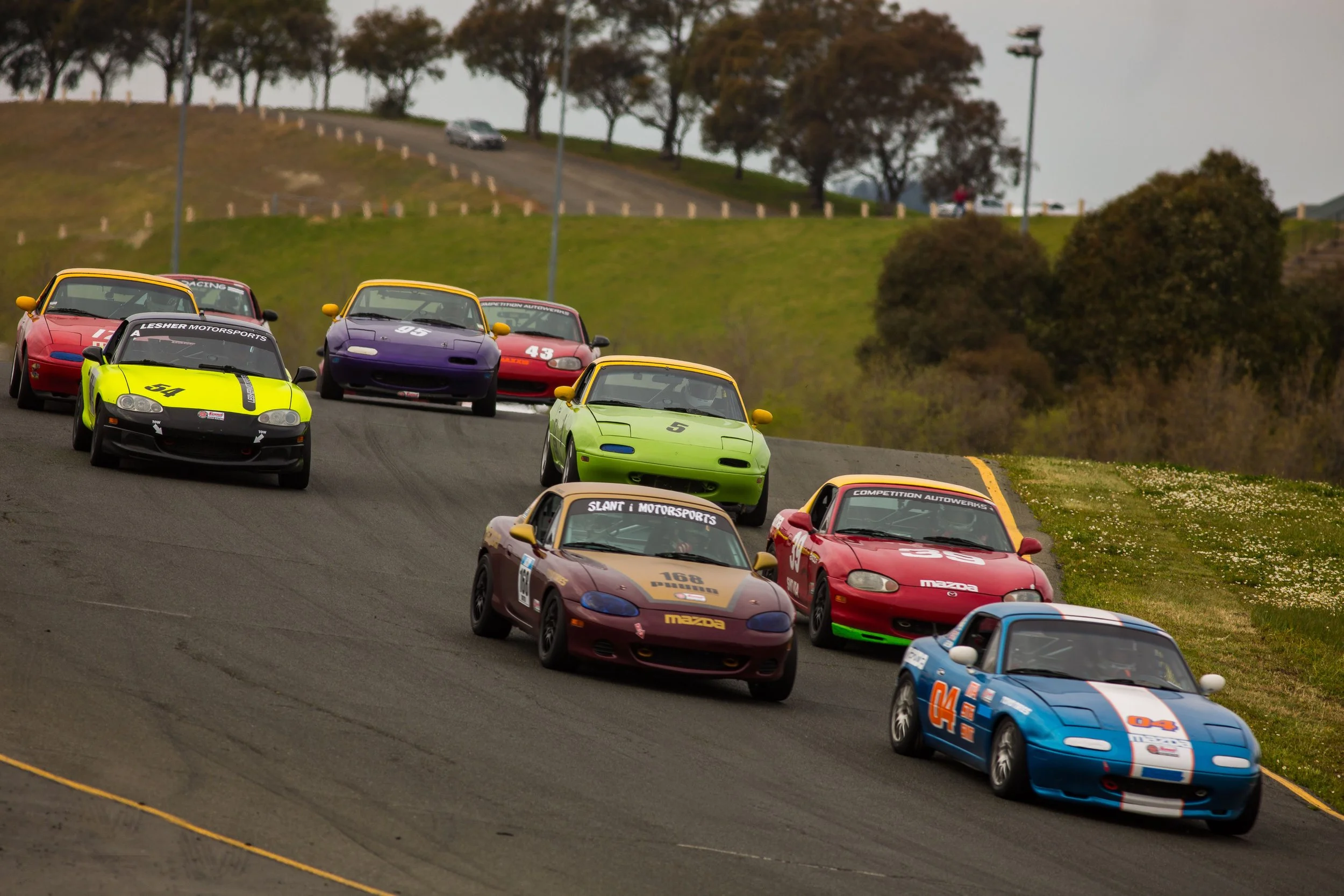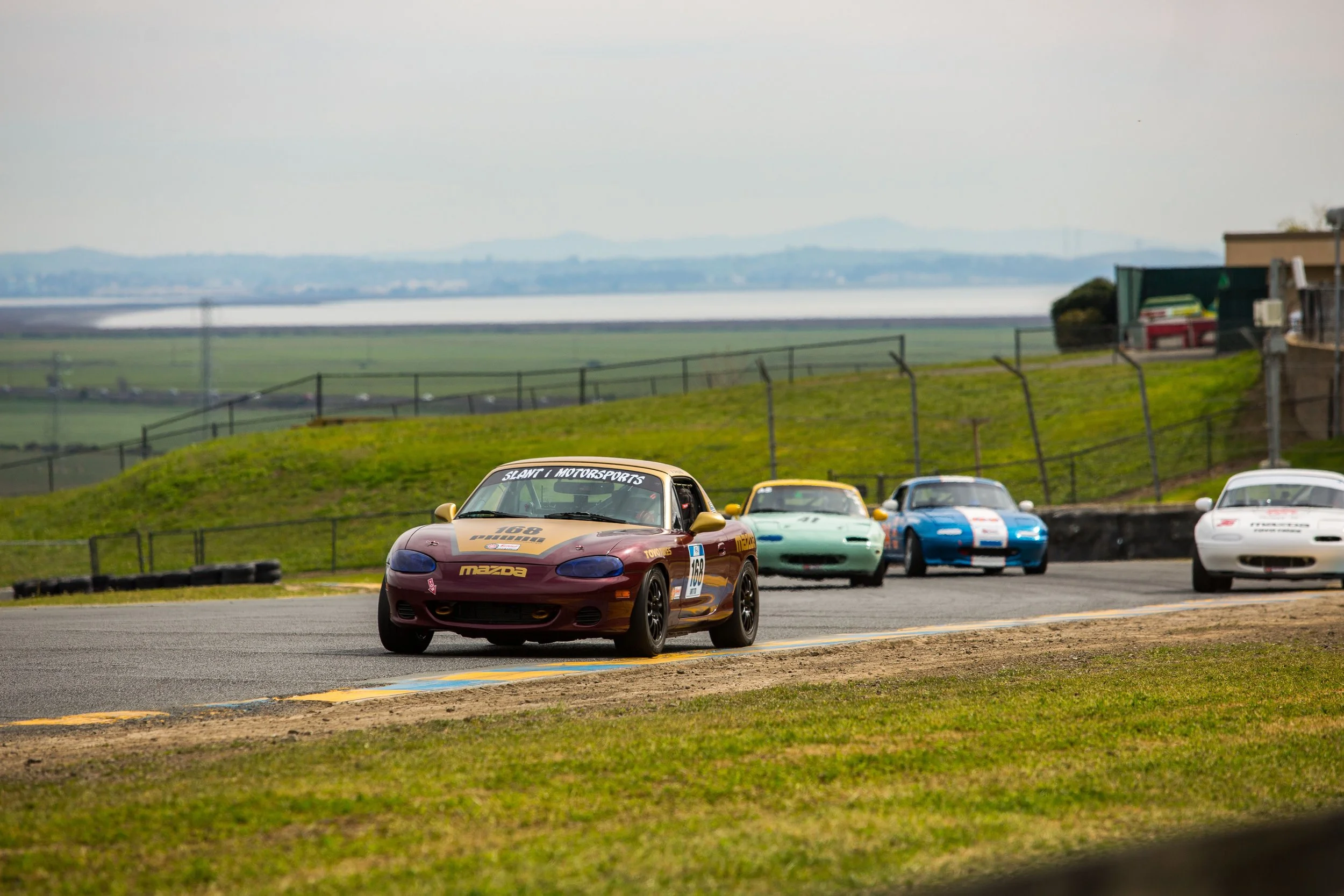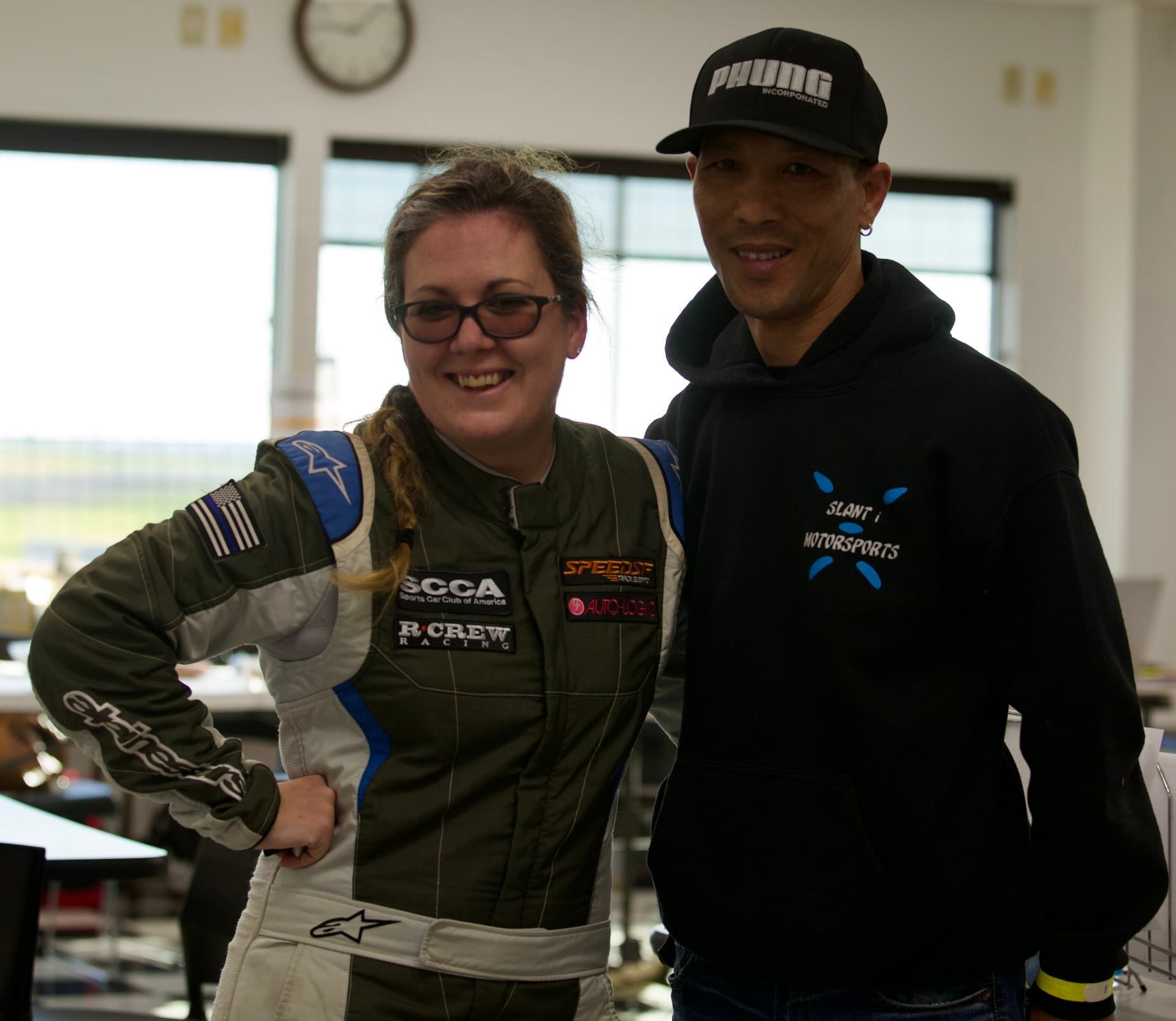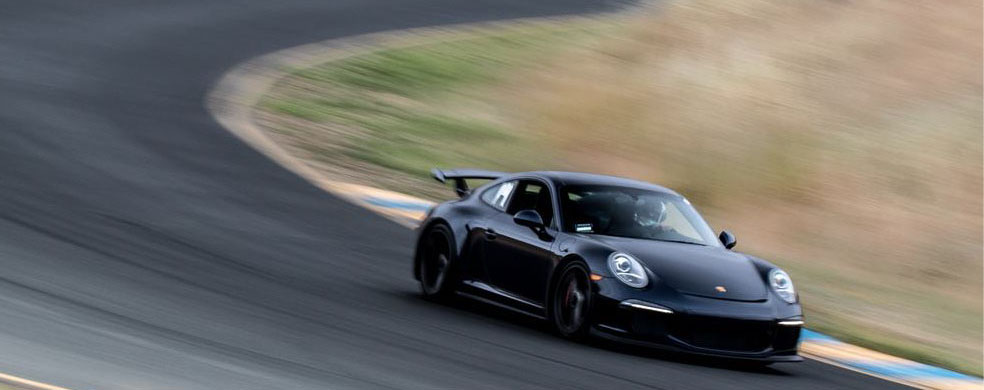
Peter Phung's Widebody M3: Wide and Wonderful
Designed to be seriously quick and sexy, Peter Phung put a lot of blood, sweat, and tears into building this no-stone-unturned E46. With 360 horsepower, amazing livery, and a GTR-inspired fiberglass bodykit, it’s a step above your typical M3 track toy.
Search YouTube for Hans Stuck Jr. romping around the Nurburgring in his M3 GTR. The widebody, V8-swapped E46 in that famous clip was as gorgeous as it was quick. Peter Phung hadn’t actually seen that video until I mentioned it to him a few days ago, but several years back, he’d found another image of that car that encouraged him to try building his own version of what some see as the ultimate E46.
Immediately after picking up the car, complete with moonroof and a six-speed, he handed it off to someone else like a negligent father. He wanted to attach the DTM Fiberwerkz widebody kit sitting in the corner of his garage, and so he entrusted one shop he knew little about with the task.
It became a pretty significant job since black paint wasn’t exactly doing it for him—mainly because he’d already pictured the ultimate iteration of this car as one with a white base. This M3 was meant to be an homage to the original GTR, which is doused in white with the M-tricolor striping. He handed it off to the professionals and waited eagerly for a pretty car to come back to him.
Peter posing beside his sister Florenza with the car wearing a simpler livery.
Once back in his hands, he was mostly impressed. The paint looked great, but the bodywork was terrible; he noticed cracked fenders and excessive fiberglass reinforcement pretty soon after. Oh well—it was meant to be a track weapon, so he moved on and started addressing the shortcomings of the stock suspension. The first round of mods consisted of Turner swaybars, and TC Klein coilovers, Brembo big brakes, and a set of Bimmerworld brake ducts.
Besides the stripped cabin and the lightweight Recaro buckets, the diet consisted of a few things: aluminum door panels, two fixed Recaros, a DTM Fiberwerkz hood, an RKP carbon roof, a removed rear deck.
Interestingly, the extra tire and width came at a serious cost to any track-dedicated car. Though made from fiberglass, the bodykit added another 200 pounds to the tally. Even after gutting the interior and taking other weight saving measures, the car still weighs in at a slightly doughy 3,100 pounds.
TC Design installed a gorgeous half-cage and made the necessary subframe reinforcement problems, then Auto Logic replaced the rod bearings with WPC coated rod bearings and refreshed the VANOS with the Beisan kit. After that, Auto Logic cleaned the combustion chamber, performed a five-angle valve job and administered the Epic tune. If the car had been given to the wrong people initially, he made sure that everyone else who touched his dream M3 were top-tier.
The one persistent gremlin that plagued them, an overheating issue, was traced to the A/C condenser. Once they chucked that in the trash, the car ran cool in the scorching summer temperatures. Powerful, tractable, and reliable—the S54 with a little work is something special.
Along with a custom fitted Borla cat-back and long tube headers, the naturally aspirated package pumps out roughly 360 horsepower—more than enough power for a heftier E46 M3.
Peter’s thinking was that if the extra weight offset its above-average power output, the wider footprint would have to compensate. To make the most from this, he deicided that he needed a better suspension system, upgraded to a full 2 way adjustable MCS pro suspension, added a set of spacers, and fitted Titan 7 wheels measuring 18 x 10.5”. Peter then added camber plates, a stiffer front sway bar and rear traction arms from Ground Control. Even with the stock differential, the combination of massive tires and a soft rear makes the BMW sticky, predictable, and easy to lean on.
There’s a constant through this build, and that’s that his entrusting the car with enough gifted people to make up for the few bad apples who got their greasy mitts on it way back when. Once he had the gifted guys at 101 Paintworks fix the widebody, he was finally satisfied with this ambitious build. Finally, the showpiece part, the amazing widebody, the thing that distinguishes this from all the other E46s, was fitted like it was supposed to be.
“It handles well, but I’d say it looks better than it performed than it did during the first phase. I did want it to look good—so at least I accomplished that goal,” he said with a chuckle. After going though five years of changes, upgrading to better performance parts and more than doubling his original budget, the car performs as good as it looks.
Simon's STI Wagon: Many Mods Spoil The Subaru
The temperamental EJ257 has taught Simon quite a lot about to the lengths one should go when building a track car. As he’s learned through five engines and a lot of trial and error, the third-generation wagon’s best asset is not its motor.
By the time Simon started tracking at age 33, go-karting was out of the question. His body hadn’t been calloused properly from driving those cost-effective but physically draining machines during his teens and twenties. Plus, being a proud Northerner, Simon wasn’t ever too eager to drive in hot temperatures, and not only does a kart puts its driver right in the middle of a heat sink, it requires them to wear a racing suit. He sought out something a little more comfortable to get his jollies with.
Always fond of the Subaru’s rally-inspired road cars, he grabbed an ‘06 WRX sedan and started autocrossing. Fearing the five-speed would shatter under the strain, he decided to upgrade to a new STI a few years later. This time, he’d have a stout six-speed, a little more power, and a fifth door. This wagon, with its softer lines and extra storage space, represented the best drive-to-the-track car for Simon.
His honeymoon phase was bliss. However, after learning a little more about the EJ257’s ringland issues, he had a little irritating voice to contend with every time he took his wagon to the track. Still, he made a few modifications, kept power outputs reasonably close to factory, and learned how to get the most out of this surprisingly swift and nimble hatchback.
Of course, his plan to remain conserative with power outputs was, well, a little idealistic. Even keeping power under the 400-whp-mark, he found that the engines kept popping. After a worrying but relatively ineffective fire during an autocross, he decided to splurge and get a fully built engine courtesy of IAG Performance.
This special lump included a parts list four pages long and a price tag not far from the cost of a stock STI. Clearly, he was committed to seeing just what the EJ257 could do when he threw everything at it. The big ticket items that might raise an eyebrow are an IAG Stage 3 Magnum EJ257 Subaru Closed Deck Short Block, IAG pistons and rods, a Supertech valvetrain, ID1300cc injectors, and a custom GTX2971R turbo that fattens the powerband sufficiently for the road course. The total power output: roughly 450 horsepower at all four wheels.
Oiling and cooling proved to be the biggest problem for this engine, regardless of its level of modification. To keep the motor lubricated at high g-loading, he ran KillerB’s larger oil pan, baffle, and pickups; as well as Crawford’s air-to-oil separator. Adding a vented hood helped extract some of the heat from the bay, and a PTP Lava turbo blanket, Koyo radiator, custom 19-row Setrab oil cooler did the rest. Though he didn’t test the car in truly scorching temperatures, it proved to stay chilly in Laguna Seca’s dry heat.
“It’s a fun car when it works. I’ve had some thoughts about returning it to stock and just enjoying it for what it’s meant to be, but I feel I’m past the point of no return,” he laughed.
Of course, it wasn’t meant to excel only on straightaways. The biggest modification he made—one of hundreds—was surprisingly simple: chassis stiffening. Between the TC four-point rollbar and the CUSCO chassis bracing—mounted mostly on the underbody, gave the once doughy wagon a much more athletic character. “It wasn’t the motor or power that surprised me most—it was the CUSCO bracing. I had to relearn everything; it’d become so tail-happy overnight!”
That edginess was dialed out for a more Massive AP six-pistons clamp the front rotors and give the 3,200-pound wagon strong braking performance and repeatable trail-braking—a must in a middleweight four-wheel drive. The platform’s inherent understeer is mitigated somewhat by getting the most offered by the KW V3 two-ways and camber plates, but it’s something he prefers; the softer edges of a push-prone quell his nerves.
Thank Christ the footwork was sorted as well as it was, because now he’s dealing with a power downgrade and the wagon’s sharp handling is now its greatest strength. Why the downgrade? It’s recently been made smog-friendly and the only real power adder is a COBB tune. “It’s a little on the slow side, but at least I’m not going to worry about another engine bill anytime soon,” he said with a smirk.
If the lengths Simon went to trying to find the most this platform can provide taught him much, it’s that there’s some sense in staying stock. “Too much worrying detracts from the driving experience, and the more modified the car is, the more I worry,” he admitted.
For now, he’ll have to learn how to enjoy a machine with grip that vastly outweighs its power output—though it’s tough calling a 300+ horsepower turbo car a momentum car. For comfortable commutes and spirited backroad driving, he’s got an EVO X on hand that he’s committed to keep near-stock. He learned his lesson with this bewitching but fickle wagon that will undoubtedly remain the focus of his excessive side for years to come.
ENGINE
IAG Stage 3 Magnum EJ257 Subaru Closed Deck Short Block
Closed Deck Block Halves
Machined for Fire Lock Ring
Machined for 14mm Head Studs
IAG Spec JE FSR 99.75mm 2618 Forged Pistons
IAG Spec H-Tuff Connecting Rods with 625+ Rod Bolts
ACL Race or King Main and Rod Bearings
STI Nitride Crankshaft
Supertech Titanium Spring Retainers and Spring Seats
Supertech Valve Spring Kit (Exhaust and Intake)
OEM Valve Guides
R&R all Intake and Exhaust Valve Guides, 5 Angle Valve Job, Head Resurfacing
Grind and Polishing Spring Ends for titanium retainers
Bowl Blend EJ Heads
IAG 14mm Head Stud Kit for EJ
Subaru JDM 12mm Oil Pump Part# 15010AA310
Gates Racing Timing Belt
RPS MAX Series Clutch with Street Disc
ACT Streetlight Flywheel
KillerB Oil Pickup
KillerB Oil Baffle
KillerB Larger Oil Pan
Miltek Catback Exhaust (with custom Laguna Seca turn away tips)
Agency Power aluminum 3" Turbo inlet (with 3"->2.4" silicon adapter). DEI wrapped
Stock VF48 turbo
Cobb FPR
Cobb Flex Fuel Kit (fully installed but unplugged from the ECU)
DW300 Fuel Pump
Koyo Racing Radiator
Custom oil Cooller (19 row Setrab core, Mocal 200F Thermostatic Sandwich Adapter)
Crawford v2 Air-Oil-Separator
KillerB Radiator Shroud
Stock rear differential with Perrin cooling cover (holds more fluid as well)
COBB OTS Stage1 ACN91 NWG map (COBB AP v3 is included)
INTERIOR
OMP HTE-R Racing Halo Seat
OMP 6-point Racing Harness
OMP Seat Side Mounts
Sparco Seat Sliders
Planted seat base (customized by TC Design)
4 Point Weld-in Rollbar (Half Cage) by TC Design
Partially stripped in the back
Small leather FactionFab steering wheel
5v USB hardwired plug for the windshield mounted camera (under the rear-view mirror).
Strong (3 point) Rollbar mounted camera mount.
EXTERIOR
VIS VRS Style Vented Carbon Fiber Hood
Cusco Front And Rear Tow Hooks
Aerocatch hood latches
SUSPENSION AND CHASSIS
RCE Tarmac T2 Coilovers with 500/500lb Springs (9k/9k)
Whiteline Front adjustable 22mm rollbar
Whiteline Rear adjustable 22mm rollbar
Whiteline Adjustable (Front) Ball Endlinks
SuperPro Rear Endlinks
Vorshlag Camber Plates (front)
2011+ STI Front Lower Control Arms (LCA)
SuperPro Front LCA Front Bushings
SuperPro Front LCA Rear (no Caster ALK) bushings
SuperPro Roll Center Adjuster (RCA)
2015+ STI Fast Steering Rack (13:1 ratio)
SuperPro steering rack bushings
Cusco Steering Rack Bracket
SPT Steering Cooler
Super Pro Rear Trailing Arm Front Bushing
Super Pro Rear Trailing Arm Rear Bushing
Super Pro Rear Upper Control Arm Inner Bushings (non-adjustable)
Super Pro Differential Pinion Bracket Bushing replacement
Super Pro Toe Arms
Cusco Rear Adjustable Lower Control Arms (Links)
Whiteline Rear Subframe Bushing Inserts
Whiteline Differencial Bushing Inserts
Kartboy Pitch Stop
Kartboy Front Shifter Bushing
Kartboy Rear Shifter Bushing
Cusco Front Lower Arm Bar Type II (H-Brace)
Cusco Power Brace Floor Center
Cusco Power Brace Crossmember
Cusco Power Brace Rear Member Side
Cusco Power Brace Rear Lower
Tanabe Front Strut Tower Brace
IAG Competition Series Engine Mounts
GroupN Transmission Mounts
Whiteline Gearbox Mount Bushings (positive shift kit)
BRAKES
Essex AP Racing RadiCal 6-piston Front BBK (Ferodo DS UNO pads)
Custom Front Brake ducts with fog light covers as duct inlets.
OEM size rear Ferodo DS UNO brake pads
OEM size rear Stoptech Powerslot Rotors
Stoptech Rear Stainless Steel Braided Brake Lines
GrimmSpeed Master Cylinder Brace
WHEELS AND TIRES
Enkei PF01 18x10 ET35 wheels (no TPMS sensors!)
Motorsport-tech custom (wheel and hub centric) 3mm front spacers for better strut clearance
Yokohamas A052 (265/35-18)
APR Wheel studs all around
Jeff Tam's E46 M3: Never Compromise Too Much
Frustrated by the wheelhop of his VW GTI, Jeff decided to pick up a rear-wheel drive. Split between an S2000 and the C6 Z06, he pondered the right course of action before settling on the middle path. His E46 M3 received its fair share of suspension modifications off the bat, and now its handling matches its playfulness.
After five months of owning his 2012 VW GTI, Jeff Tam took it to his first ever track day. After that eye-opening afternoon at Thunderhill East, he knew he had to make room for his newest love in life.
The honeymoon phase was predictably sweet, but once he’d turned enough laps to become a discerning driver, he was frustrated by the front-heavy VW’s torque steer and wheelhop.
The GTI was a great car for him to find his feet as a track driver, but he knew he wanted a rear-wheel drive car with a higher base potential. There were a few candidates, but they all had their shortcomings.
The JDM Tax kept him out of the seat of an S2000.
The big-power candidate, the C6 Z06, pulled hardest at his heart strings. However, a little research revealed that its LS7 engine was plagued with a valve drop issue.
Around that time, Seigo Ma sent him a listing for a nicely sorted E46 M3. Jeff realized that for the amount of the S2000’s silly surcharge, he could take the middle-path car and sort it out for track use. By that point, he was tired of weighing the options and pulled the trigger.
The previous owner had spent some time prepping it for track work before he decided to get into shifter karts, so Jeff took on a project that was largely sorted. Included with the car were a CSF oil cooler, a CSF radiator, a CAE hard mounted shifter, Vibratechnics race engine and transmission mounts, a Moroso aluminum coolant expansion tank, CPI stepped headers, as well as a mild engine tune. The result: a quick, direct car that could run laps without issue.
While his sim experience had given him the hands to control a little oversteer, he recognized his hands might not be fast enough to catch the bigger drifts this M3 was capable of. So, after a year of ownership, he installed an OS Giken 1.5-way and enrolled in a drifting course. With a bit of instruction, he found the car to be predictable and reassuring, even if it was spinning up the rears.
Part of that comfort came from the M3’s benign nature, the predictability offered by the differential, as well as a few new parts. The first area he focused on was footwork. One of the few shortcomings of the M3 are its undersized brakes; fine for spirited driving but inadequate for track work. An AP Racing BBK shortened braking distances and helped him trail-brake more consistently.
He understood the reason for splurging and doing it right the first time, so he grabbed a set of MCS 2-ways with remote reservoirs. The prevalence of track-tuned E46 M3s made it easy to find a good setup, and a set of Ground Control camber plates and Megan Racing camber arms made getting the right alignment possible.
Any excessive tail-happiness was quelled by the mild aero package. It didn’t take much; a homemade Alumalite splitter and a Voltex Type 7 wing gave him the reassurance to push hard in the fast sections. The first event after donning the new wings, he lopped a couple seconds off his previous best times.
Along with the athletic stance, a homemade alumalite splitter and Voltex rear wing give this M3 an unmistakably serious appearance.
His proximity to Sonoma, his favorite track, lets him party the night before and still wake up in time for a track day.
The increased speeds he was hitting encouraged him to improve the car’s safety. In went a Kirk Racing half-cage, a Bride bucket seat, and 6-point Schroth Profi harness.
Perhaps the biggest accomplishment with the build is its general level of balance. The power, thanks to the stepped headers and HTE Performance tune, is progressive in its delivery. The differential puts the power down well. The general balance is neutral-to-oversteery, but thanks in part to the linear delivery of the motor, the car is still very manageable when sliding at the rear.
There are still a few items on the to-do list needed before he’s able to match the lap times set by his role model: Dan Avon. Dan’s lightweight car is the more focused machine, but Jeff’s is rapidly becoming as spartan as Dan’s.
After deciding to have the carpet stripped from the b-pillars back, Jeff committed to tread down that path that represents the death of a street car in the truest sense of the term. Nevertheless, the versatility of his E46 M3 should not make Jeff hate his drives to and from the track.
Jeff’s proven one thing with this particular M3. He’s made sure that reliability, fun, emotion, speed, and sanity—all equally important to him—can be had when the tuning approach takes everything into consideration. Usually, the word “compromise” has a negative connotation when applied to a car, but this M3 proves that it doesn’t always have to.
Ed Susman's 718 Cayman: Proving the Four-Cylinder's Potential
After years of tuning flat-fours in Subarus, Ed Susman realized he might have a new audience if he learned to tune the new Porsche Cayman with that engine configuration. As he learned, it didn’t take much to make this 2.5-liter engine seriously powerful.
Caymans are a common sight at Northern Californian tracks, but not many of them make over 400 lb-ft of torque. Though the six-cylinder variants have a grander sort of appeal, Ed Susman, a Subaru tuner with a penchant for turbocharged flat-fours, saw the potential in the new 718 chassis with the 2.5-liter engine.
Now, with a seriously wide footprint and suspension upgrades to match the gains in grunt, his turbo Cayman has been proven as a particularly quick car on both quick and slow circuits. Even better, there’s still so much potential with the platform which Ed, an obsessive tuner, aims to unlock.
Now that Ed has gotten intimate with this force-fed, four-cylinder midship, he’s been able to give this car a dash of the old 911 Turbo ferocity that makes it a very different car to drive. Unlike the atmospheric variant, this Cayman requires the driver treat the throttle with extra concern. Does one sacrifice a little mid-corner speed with so much power available? Possibly, but if there’s a delay in throttle application, the straightline advantage makes up for whatever difference there may be—and then some.
The factory output—365 horsepower and 309 lb-ft at the flywheel—is nothing to sniff at. More importantly for low-speed tracks, it’s the way the motor just pulls from zip that changes its character so much. from that of the high-revving atmospheric versions. A flatter mid-range and a screaming crescendo isn’t what this motor offers, instead, it pulls like a sled dog from virtually everywhere in the rev range. Because it makes its peak torque figure from 1,900 to 5,500 rpm, it really doesn’t matter which gear is selected. It’s this ability to keep the car moving forward at about any speed is something else which cannot be savored with the old naturally-aspirated motor.
Not surprisingly, those figures were a little on the conservative side—just as Porsche is wont to do. After Ed got his hands on the motor, all it took was a downpipe, an E30 blend of ethanol, and a little tuning on the factory ECU to extract serious gains.
Of course, it wouldn’t be possible without Ed’s magic. The motor now makes 460 horsepower and 440 lb-ft at the rear wheels. Even wilder, the powerband has been broadened some; pulling harder from 3,000 rpm to 7,500. As crazy as it might sound, there’s still more mojo available—it’s just that the fuel system needs a little beefing up before it’s accessible.
Since the peak figure is available just shy of 2,000 rpm, it makes the delivery a little less than linear. Depending on the tires he’s using, he switches between two maps on the Cobb Accessport to soften the mid-range torque. If he’s using A052s or Supercar 3Rs, he gives it the full enchilada. If he’s on street tires, there needs to be a slight softening of the gradient of the mid-range ramp in order keep the rears from spinning everywhere.
Regardless of compound chosen, Ed had to throw a set of 305s on the rear if he wanted any traction in the second-gear hairpins. Thanks to Apex Wheels for giving him a set of 19X9 and 19X11” SM-10s, he was able to get the desired amount of rubber within the the factory bodywork without any rubbing or rolling. Somehow, they fit underneath the factory bodywork.
More than mere meat, the secret to its inspiring traction lies in his clever throttle tuning. Now, there’s a more linear throttle position-to-output to make that horse-kick delivery a little more manageable.
With the car making serious horsepower with relatively little work, Ed now had a series of figures he could attract a whole new slice of clientele interested in making their Cayman dust GT3s on the freeway. His work had only really begun, though. To get the car to do what it’s supposed to do best, he had to improve footwork to complement the free-breathing motor.
The list of upgrades is refreshingly short. With a set of camber plates; SPL control arms, camber arms, and toe links; and Ohlins Street/Track coilovers, he’s been able to make the car much, much more manageable. “Where it was nervous, it’s now neutral,” he declared.
The footage below definitely conveys the violence of the turbo motor—even if the muffled soundtrack doesn’t. Ed has to tread carefully, otherwise the turbo motor simply monsters the driven wheels. Still, there’s a real playfulness to it all. Clearly, the turbocharged motor suits the Cayman, but it changes the emphasis from rolling mid-corner speed to getting the thing pointed and administering that power. While he might not be able to lean on it like he might in a similarly sorted atmospheric variant; it still looks predictable and playful.
The car still has a lot of work ahead of it if Ed’s going to be satisfied. The front end simply doesn’t cooperate as he’d like, mostly in the high speed sections, and so he’s planned a bit of aero and weight reduction to help this car point as he’d like it to. For now, he’ll keep himself busy improving the deftness of his right foot—his brilliantly tuned engine is still grunty enough to roast the rears in fourth-gear corners.
Speed SF's Inaugural Night Event A Great Success
After protracted negotiations with the county, we were able to host the first nighttime track event in Northern California. For all involved, this was a totally new experience that had our veterans re-learning a track they thought they knew inside and out.
Aside from the 25 Hours, Thunderhill Raceway never runs events past 5:00 PM—until recently. The soaring heat and growing demand for tolerable track days throughout California encouraged us to try and find better solutions to serve our drivers. With the help of David Vodden, Schuyler VanBuskirk, and the rest of the Thunderhill staff—they definitely put their hours in dealing with the county, we were able to give our drivers an experience typically reserved to well-funded NASA racers.
If we could avoid noise complaints by instating a 95-decibel limit, we were able to bring in some of our more experienced drivers to drive in the darkness. Though we wanted to extend our run groups to midnight, the best we could manage was a 10:30 cutoff. Still, with sessions starting at 5:30, the night kids had plenty of time to play. This way, they at least had a shot at reacquainting themselves with the track and memorize the rhythm. After the sun set, they’d be relying a lot more on their internal stopwatch and muscle memory to guide them through the areas not illuminated by the seven operating light towers before the sun set.
Once the sun was out of their eyes, they had to begin picking special reference points and other landmarks visible in the dwindling light to help them through the night sessions.
Because of the added challenge of running 100+ miles an hour through unlit areas of rolling farmland, only intermediate and advanced drivers were allowed at Speed SF’s inaugural night drive.
Corner workers used flashing lights instead of flags, drivers were encouraged to use their blinkers to signal point-bys, and a generally more conserative approach when alone or in a pack. Visibility being what it was, they had to exercise a little caution and accept they’d be a little off their daytime pace.
“It turned out that some of the stock headlights didn’t cut it,” Patrick mentioned. “Some guys taped rally-style lightbars to their hoods and others had underglow!”
“I wasn’t trying to PB or anything,” said Seigo Ma. “I was taking it slower—I was driving on memory. It was a totally new experience and a lot to take in—so I’m glad I was able to sleep in that morning!”
Others were more excited at the new challenge. “It was one of the best events ever—and also one of the scariest,” said Gary Wong. “Like driving a new track, almost. I had no idea when to turn in, brake, or apex!”
Though that was the M.O. for most of the drivers in attendance, some of the kookier ones took advantage of the colder temperatures and went a little faster. For a guy like Tony Rodriguez, a guy who certainly isn’t scared of throwing his car in and sorting it out mid-corner, visibility was a relatively small impediment. He managed to chop a few tenths off his best time and bring a little more competition back into the relaxed paddock.
There are talks about trying this format again in the near future. As you might imagine, there are a lot of negotiations with the county and the neighbors involved. However, if we stick to the demands made, we should be able to offer this again to our returning drivers and other first-timers looking for a totally new experience.
EDIT (8/3/22):
We have successfully arranged another nighttime date with Buttonwillow Saturday, August 27th. To sign up for the event, visit this link.
Kevin Schweigert's GR86: Back to Basics
After several unfulfilling years spent chasing big power, Kevin’s realized that the quality he most appreciates in a sports car is its incisiveness and communication. After a return to a simple, agile GR86, he found that thrill that got him obsessed with trackday driving in the first place.
Kevin Schweigert’s fondness for the little Toyobaru products has waxed and waned over the last decade. His first, a first-generation BRZ, gave him that feeling of involvement that had him hooked. The lack of power led him to supercharging its engine and pushing power near the 400-mark, which proved to be a backloaded decision; axles and gearboxes needed replacing soon afterwards.
Tired of dealing with the temperamental blown BRZ, he traded it for a stouter A90 Supra that could happily handle 500 pound-feet. However, the Supra’s heft, increased running costs, and softer edges didn’t excite him quite like the little BRZ once did. In fact, he even considered hanging up his helmet.
Despite big power and impressive lap times, the softer Supra didn’t excite him like his BRZ did.
Thankfully, he didn’t have to do that. After getting a shot at testing his friend’s GR86 last winter, he sold his Supra and sprung for another normally-aspirated, lightweight, visceral, and raw machine. This time, another .4 liters will have to do; Kevin’s done with boosting an FA motor.
Without the former cars’ power, the new GR cannot hope to compete on longer tracks, but its combination of a larger motor and low weight is keeping Kevin quite busy. Significant torque increases and similar gains at the top end mean it’s happy to dance around in third gear in a way that the previous BRZ pre-blower never could.
Though power adders aren’t a priority right now, he’s planned out a few bolt-ons to get the FA24 making something closer to 250 horsepower at the rear wheels. A few duels with a lightly tuned AP2 S2000 has proven that it’s not lacking any straightline speed—and that’s with just a Counterspace Garage Spec Touring exhaust bolted on. This was done mainly for the fact that he couldn’t live with the digitized noise piped into the cabin. “It just wasn’t right,” he said.
He’s made good use of his connections at Counterspace Garage to get his latest acquisition into fighting shape—not that it needed much help. His list of modifications is fairly short, but the effect is obvious. “I wanted more stability and sharpness via the coilovers,” he stated. Thankfully, the ones used didn’t cost him much—they were once the coilovers he ran on his GR. “I had them revalved for 2kg less spring rate since this car is driven to the track,” he added. These CSG Spec Tein SRC V3 (7kg F 8kg R) aren’t the only hand-me-downs—he’s also got an OEM 2013 rear sway bar. Two hand-me-downs and he had all the pointiness he was after.
Stopping also needed some work. For Kevin, the CSG Spec C1/C11 pads don’t fade, last forever, and offer great modulation. Of course, a wider set of shoes helps there, too. His car wears a set of tasteful 17x9.5” Volk TE37 TA +44, including a 10mm front spacer, shod in 255/40/17 Maxxis RC-1 R2.
At this early stage in its development, he’s been able to go sub-two at Buttonwillow CW13 without wings or slicks, and from the onboard footage, it’s not hard to see why. Assuming the angles are kept reasonably shallow, the car can be shimmied in on the brakes and wiggled through the middle of the corner—several times if necessary—to get through the corner quickly and stylishly. The straightline speed isn’t anywhere near as great as his Supra’s, which also likes to dance around in this fashion, but the GR’s low weight, moderate power, and greater communication makes it a more involving drive.
“It’s pretty much telepathic,” Kevin adds.
It’s got the right sort of rack as well as all the sensory inputs needed to keep an aggressive driver completely engaged and satisfied—straightline speeds be damned. An audible beep every time he nears redline, plus a rife bolt-like throw of the gear lever help the 2.4-liter motor stay in its ideal range. Again, this engine’s not a top-end screamer, but the added displacement means the ratios don’t need to be shuffled through so frequently, and that rear end will move around just a little more with some third-gear stabs of the throttle.
That willingness to rotate, plus some mild engine tuning and a few aerodynamic additions might make this GR a contender for the S4 title. Will Kevin take the crown? It’s hard to say, but it’s definitely in the realm of possibility. What’s certain is that he’s rediscovered his love for tracking—and that’s what matters.
Showdown at Sonoma: Battle Between the Fastest Stateside A90 Supras
Jackie Ding and Will Kwok have both gone quite far in tuning their A90s—further than any others on American soil. With Gary Wong piloting Will’s machine, these two drivers demonstrate where variations in tuning are felt most around Sonoma Raceway.
They’d known each other from the forums and hours on the phone, but they hadn’t met in person. For the last few years, both Jackie Ding and Will Kwok have developing some of the fastest A90 Supras in the country, and only recently were about to partake in some friendly competition.
Jackie’s PhD Racing Supra, now famous online thanks to his growing YouTube channel, caught the attention of Will in 2019. “Will quickly became a huge supporter of PhD Racing Lab and is now our biggest customer. He’s always a great guy to talk to, so he was one of the first people I told I was coming out to the West Coast. Naturally, we started talking about a little battle when I was there,” Jackie told us.
It was Gary Wong, Will’s hired hotshoe, who supplied Jackie with Speed SF’s schedule. Jackie picked the dates that interested him, and the two decided to have themselves a duel. If Jackie couldn’t finish more than a half second ahead of Gary at Gary’s home track, he’d have to buy dinner.
Footwork
Since Will got most of his pointers from Jackie, perhaps first real time attack driver to develop the A90 Supra in the U.S., the parts used on the two cars aren’t that different. Both share most of the SPL catalog available for the A90, including the SPL front lower control arms, SPL adjustable front caster rods, SPL rear toe links and eccentric lockouts, SPL bumpsteer correction kit, SPL rear traction links, SPL rear upper lateral links, and SPL front swaybar endlinks. There are a few notable differences, though; Jackie’s car sports the Reinharte two-ways coilovers while Will’s is on MCS three-ways.
Powerplants
Supras have a certain reputation to live up to, and both these cars do that with over 1,200 combined horsepower. Jackie’s B58 is improved with VP MS109 direct injection and a Garrett GTX3076R Gen 2 as part of the AMS Alpha 6 turbo kit. The total output: somewhere in the 650-horsepower range.
Will has explored a little more of his motor’s potential. His sports the Pure800 turbo, flex fuel, and port injection,—enough for 700 horsepower at the real wheels, depending on power map. The power outputs are similar, but Jackie has to leave a little on the table as his gearbox hasn’t been built, unlike Will’s.
Though slightly heavier, Will’s car is a little faster on the straights due to a stronger gearbox and another fifty horsepower.
For both Sonoma and Laguna, both cars sported the same tires: 275/40/18 CSR. However, the grip levels provided varied due to weight and aerodynamics. Jackie’s car-driver combination is somewhere around 150-200 pounds lighter than Gary and the purple car, and the configuration of wings and splitters are different enough to provide very different characters. While Will’s car has the Spage V1 front splitter, Jackie’s has the V2. Both running the Spage SP012 68” swan neck GT wing, but Jackie’s wing is mounted slightly lower for a less understeery setup.
Similar setups, similar parts—that would be the case since Will has relied on Jackie for tuning advice. However, their design ethos differ somewhat. Jackie’s car is much more suited to the high-speed stuff, while the purple car is more compliant, more squishy, and better suited to the slower tracks on the West Coast.
Subtle Differences OVER one Lap
For the first half of Sonoma, Gary held the edge. The bumps in Turn 1 were tough, but when it came to hard braking and high-speed direction changes, as in Turns 7 and the 8/8A esses, Jackie and his slightly pointer car pushed ahead. Turn 10 obviously favored the aero grip of the red car, but it wouldn’t be fair to say it was as simple as turning the wheel and matting it. As we can see in the footage below at 8:53, a little braking too late and adding a little too much throttle after the speed change prior to Turn 10 caused a moment which might’ve given Jackie a little heart palpitation. Without a doubt, Sonoma is a driver’s track that Jackie had to learn in a hurry.
“Their car handled the bumps better, so in sector 1 at Sonoma, Gary definitely had an edge on us. Our car, being more stiffly sprung and heavy on compression, is a really high-speed focused aero car. While we lost a little in Sector 1, we gained that back in Sector 3’s high-speed esses,” Jackie elaborated.
“I was surprised with the braking performances. We were both running the same CSG pads, but I think I had more confidence in my brakes, even though I’ve only got a Stoptech Trophys on the front axle. Will’s car has APs 9660s front and rear. I think the big reason for that was our more advanced front splitter; having that extra downforce gives us extra front grip under braking,” he added.
At the end of the day, the main difference was in downforce. Both cars produce comparable grunt and share the same footprint, but subtle changes in aero balance and perhaps a slightly svelter shape gave Jackie a slight edge around Sonoma, though it’s only fair to mention he’s been developing this car longer and driving it a lot more. Still, nobody felt shortchanged at the end of that glorious day. Sonoma’s not the easiest of tracks, and it definitely doesn’t suffer fools, and to put that much power to the road through moderately sized tires and not crash is an accomplishment in itself. Dinner looks cheap after the cost of a smashed carbon clamshell.
Dan Avon's E46 M3: A Study in Taking Things Slowly
Done slowly, done carefully, done right. Dan Avon’s showed us how to take a mild M3 and make it far more than the sum of its parts.
One doesn’t need to have a big V8 or a turbo to go quickly at most of Northern California’s medium-speed tracks. They don’t necessarily need a featherweight, either. The E46 M3 sits somewhere between the two. Weighing in at 3,200 pounds and making a healthy 300-odd horsepower with moderate torque, it straddles the fence between momentum car and muscle car. With the right touch and a few chassis mods to help bring out this middlewight’s best attributes, namely its handling, it remains a hard car to beat.
Dan Avon took a comprehensive approach to tuning his 2004 M3; engine power, grip, balance, and braking performance were all valued evenly throughout this build’s three or four stages. Most importantly, he’s learned how to gel with the car by fine-tuning its handling so that it complements his driving style.
Its first iteration as a mildly modified road car was fun, though he felt the plush nature of the M3 was limiting its on-track performance. That didn’t concern him much as he was still driving it to work, to the grocery store, and through the canyons. The motor made ~285whp with a set of Status Group Tuning headers and a Dinan muffler, and with a full interior, it weighed ~3,400 lbs with driver and a half-tank of gas. Despite those less than stellar figures, the broad powerband of the motor and the playfulness of the car were satisfying enough to overlook its shortcomings.
Except some. The factory suspension was not up to snuff, so he added TC Kline D/A coilovers, rear camber arms, and polyurethane trailing arm bushings. Even with these modifications, it was very much a street car. His growing fascination with developing the car and improving his lap times meant he’d stuff track wheels in the car before driving it to the track, but it was still doing double-duty.
He started stripping the car slowly and systematically to help give it a feeling of agility. Being a plush car, it wasn’t hard to remove a couple hundred from the total. It then became clear that the Brembo brake kit wasn’t really as inspiring as he thought they’d be, plus the consumable costs were high, so he eventually swapped those for a set of PFC binders.
With an AFe Stage II intake and a Epic Motorsports tune, he now had 300 horsepower at the rear wheels. Again, he made sure to address every area of performance through the various stages of modification, so even if the improvements seemed insignificant on paper, it felt more alert, competent, and encouraging. The M3 was always meant to be more than just the sum of its parts.
Weight reduction became more and more important to him as he learned to push harder, so after five years of worsening this car’s civility, Dan decided that the M3’s days as a street car were over. He chucked most of the carpet, door panels, and roof liner to get it down to a respectable 3,100 pounds with driver and a half-tank.
Increasing his cornering speeds and just generally working the car harder revealed some of the limitations of the factory differential. When he installed the renowned OS Giken 1.5-way differential with aluminum bushings, he could generate much more propulsion off the corner, even if the rear was moving around slightly. At the same time other areas of the rear suspension were addressed with various mono-ball bushings in place of the previous poly bushings.
Not that it was ever tailhappy. His setup was neutral to oversteery; an extremely satisfying and manageable balance that helped yield some great lap times. Still, he wanted to experiment with a little aerodynamic grip—even if that risked the near-ideal balance he’d achieved..
With a Bimmerworld rear wing and a homemade front splitter, the car had even more stick in the braking zones and the few high-speed corners at Thunderhill and Sonoma. The upside was that the lap times immediately fell by a couple seconds.
Unfortunately, that aero grip came at a price. The once playful car was suddenly arrested at the front end; a persistent mild understeer kept him from enjoying the car like he once did.
In an attempt to take some weight off the car, particularly off the front, and restore some of that neutral handling he once enjoyed, he added Supersprint V1 headers and Section 1 midpipe, a Bimmerworld cat back race exhaust, a Ground Control hollow front sway bar, a rear-mounted Antigravity battery, and Bimmerworld carbon headlight blanks. These measures saved nearly 200 pounds in total, but the push was still plaguing him. At least the car was significantly quicker.
Frustrated with the balance but happy to see this car evolve into a no-compromise track toy, he continued to stiffen and harshen. Why not? He’d already decided to start trailering this dedicated track car, so he had no reservations about adding a rear half cage from TC Design, Turner Motorsport solid aluminum engine and transmission mounts, a set of MCS three-ways, and a Racetech 4119 halo-style bucket.
Life has gotten in the way in the last year, but he’s still fascinated by the car—and hopes to return to regular lapping days in the near future. “I’ve always enjoyed tinkering and seeing what improved the car and what didn’t. I’ve used my AIM system to determine exactly where the tweaks paid off. I guess that’s what motivated me most of the way.”
He’s still frustrated by the current balance, so he’s pondered two possible paths to follow once he gets back into the swing of things. Either he removes the aero and tries to optimize the mechanical grip of a lightweight car, or he finds the biggest, meanest cattle plow of a splitter he can find to give the front some much-needed aero grip. Either way, he’ll be measuring incremental improvements and sticking to his basic philosophy of addressing every aspect of performance and taking baby steps. Seeing how quickly this middleweight, mid-powered M3 navigates Northern California’s best tracks, it’s certain this steady, methodical tuning approach works.
A Letter to Our Open-Top Drivers: Is a Rollbar Necessary?
Though not every factory convertible requires additional roll protection to run a lapping event, there are some that do. In either event, the addition of the right rollbar has a few performance gains that the daring driver will appreciate.
If you’re a Miata driver like me, you’ve been through a bit researching rollbars. They’re a necessity that worsens the practicality of an already impractical car. However, they do make life much more enjoyable when it comes time to tracking.
Purposeful looking, potentially chassis stiffening, and, of course, safety adding. Considering how the list of essential trackday modifications for a lightweight car like a Miata is quite short, the additional $500 needed to help ensure an unscathed exit from the car is money well spent. Moreover, the relief which comes with knowing you’re decently shielded from an impact, you gain the confidence to go harder and experience the thrills your time and energy should be rewarded with. Isn’t the whole point to feel comfortable enough to push?
This Harddog M1 rollbar set me back a mere $350 and only took a couple hours to install.
Though the initial investment isn’t much, you’ll have to pay in other ways. Say goodbye to some space inside the cabin. Also, make sure there’s proper padding in place. The last thing you want to do is spend the time and money installing a rollbar and then clonk your head on it. Though the padding may seem unreasonably stiff to the touch, it’ll deform just the right amount when your head hits it at high velocity.
For those of confused on the definition, let’s spell it out in perfect detail. A roll bar (defined here as a protection hoop with four mounting points) will help protect the occupants in the case of a roll over accident. Additional plusses include stiffening and a place to mount your seat, harnesses, camera, fire extinguisher, and whatever else you need in your cabin. It does come with some setbacks, however: a heavier car and reduced rear visibility being the main two.
We adhere to the usual broomstick test. This test, usually verified by laying a broomstick on top of the the rollbar and the a-frame, is meant to determine if the highest point of the helmet is beneath this line between the two highest points on the car. Obviously, any helmet protruding above this line will not be sufficiently protected in a rollover.
Many open-top race cars come equipped for rollovers from factory.
Sadly, the seriousness of the build isn’t the determining factor when considering which rollbar to buy. Some cars, like the Miata, require one to be added to run most HPDEs. Some cars are equipped more adequately for track use from the factory, and require no such addition. However, a little extra safety isn’t a terrible idea when the speeds are consistently rising. The question remains: how hard do you feel like pushing?
When it comes time to start investigating the various safety options out there, it’s good to remember that there are some shysters happy sell you some scaffolding that wouldn’t support the weight of a golf cart in a rollover situation. We’ve listed a few proper rollbars which won’t crumble—and will give you enough confidence in your car to get after it.
Even if it’s not strictly required by the sanctioning body, some additional rollover protection for the open-top car isn’t a bad idea.
Acceptable roll bars include, but are not limited to, the following:
Hard Dog units including the AC, D (center-braced model only), AB-M1 Hardcore, TB-M1 Hardcore Hardtop, 9B-M2 Hardcore, and NB-M2 Hardcore
Auto Power Street Roll Bar, Street-Sport Roll Bar, and Race Roll Bar
Blackbird Fabworx (Miata / MX5/ 2017 Fiat 124) SD (for NA and NB), RZ (for NC and ND), and GT3 (for NA, NB, NC, and ND)
Known Convertibles that will pass tech “as is” from the factory
Targa top vehicles — OK
Audi A4 / S4
Audi TT Roadster (2009)
Aston Martin DB9, DBS
BMW 1 & 6 Series
BMW Z3 (Optional pop-up bars)
BMW Z4
BMW E36 (Optional pop-up bars)
BMW E46
BMW E90
Chevrolet Corvette C8
Chrysler Crossfire
Dodge Viper
Ferrari 355
Ferrari 360
Honda S2000
Honda Del Sol (top on or off okay)
Infinity G37
Jaguar XK8 / XKR
Jaguar F-Type
Lamborghini Murcielago / Gallardo
2002+ Lexus 430sc
Miata NC & ND
Mercedes SL (1990+)
Mercedes CLK, SLK, E Class, C Class
Mini Cooper 2009+
Nissan 350Z / 370Z
Porsche Boxster
Porsche 991 / 996 / 997
Saab 9-3 (2004+)
Volvo C70
VW Eos
Some newer Beetles — years pending
Obviously, the list of acceptable convertibles is growing. If your vehicle is not on the list, you must provide factory documentation stating that your make and model have rollover protection. Factory-produced sales brochures and websites (a link may be sent), letters, or emails—which must be on letterhead or use the manufacturer’s domain—from an employee of the factory are accepted. The letter must state very specifically that the vehicle does indeed have rollover protection. If it was an option (e.g. pop-up roll bars), then you need to prove your car has these. If your car isn’t listed, contact info@speedsf.com and let us know.
Though the chances of a rollover are slim, it’s important to prepare for the worst. But more than that, having the right safety equipment will help a driver make the most of their time on track and rest knowing that they’ll be fine in the event of an incident. That reassurance will help them push and gets nearer to the limits more of the time, and that’s what it’s all about.
Seigo Ma's S2000: Grip and Reassurance
Aiming for a place at the sharp end of S3, Seigo Ma turned this S2000 into a predictable, reassuring machine he could lean on without fear. With a lot of aero grip, the S2000 is sticky enough to chase down cars twice as grunty.
Photo credit: Jebin Huang
Seigo’s had a thing for lightweight Hondas since day one. His foray into track driving came through an RSX, and after about four years of that, he tried his hand at FR with an AP2 S2000.
With Gary Wong’s car in his reticle, Seigo started building this Silverstone Silver AP2 into a car that could run at the sharp end of S3. He began with a set of HKS Hipermax 4 SP coilovers, Stoptech ST40s at the front, and whatever inexpensive tires he could get his hands on. Cheap was the operative word with rubber choice; seat time was everything at this stage—especially if he wanted to get anywhere near Gary and his clean, measured, unruffled driving.
Photo credit: Jebin Huang
Despite it being his first FR, Seigo took to the S2000 quickly. Being an AP2, the rear is slightly more stable than its predecessor’s, but that doesn’t take away from the the accomplishment of adjusting so quickly to a very pointy car. Modeling his S2000 after Gary Wong’s car, he made some of the same changes to setup which help Gary drive quickly without taking in too many liberties.
After he grew tired of the silver paint, he applied a metallic green wrap to help his car stand apart.
He made sure the car remained stable and predictable at the rear so he could push comfortably. “The OS Giken differential, man! After I rode in Gary’s car, I saw how much better the car could exit corners. He’d just stand on it and the rear would take it,” Seigo said.
While the pumpkin was off, he changed the final drive to the “happy medium” 4.3. This was just enough to keep the motor out of its lackluster mid-range more of the time without the inviting constant shifting a 4.44 would require.
And if he was going to get a more stable rear, it only made sense he’d find more composure everywhere. The addition of a set of JRZ RS Pro 3-ways, found secondhand for a steal, he could hustle this car over rough spots, berms, and undulations like never before. “After the JRZs, the dorito at Thunderhill West was just afterthought,” he laughed.
Further improving the stability of Seigo’s S2000, he went for a little aero. “I didn’t want to spend thousands and wait months for a real one, so I got an Voltex Type II replica that I eventually replaced with a swanneck-style replica.” Now, the S2000, which he’d just recently wrapped a metallic green, had much more stick at the rear than most in its league.
To help the aero balance, Seigo added a trick Racebred Components front splitter—the pretty one with tunnels. These help produce more downforce than the traditional flat splitter. In theory, the tunnels work with the fender vents to help reduce front end lift.
By that stage, he’d addressed the main aims regarding balance and grip, arguably the most important traits with a track-focused S2000, so a few power adders were in order. The list was short: a Blacktrax tune, a 70mm Ballade exhaust, Mugen header, and an AFe Performance intake. The total output wasn’t much on paper, but 230 horsepower at the rear wheels in a 2,700-pound car with the right gearing is a surprisingly quick thing.
Still, horsepower was never its thing and will likely never be. “Power adders are expensive, so I’m just going to focus on weight reduction for now,” Seigo added.
Never feeling torque-limited has payoffs—namely in corners where the tires are thrust into the pavement. With a flat underbody extending all the way from the splitter to the Spoon replica diffuser, he’s able to take some quick corners without much concern. With Thunderhill’s Turn 8, it’s just a matter of turning in and staying flat—all at around 108 miles an hour.
“It’s so easy to drive at the limit now! It does exactly what you want it to do, and although it doesn’t have that much power, it can catch more powerful cars—even at Thunderhill East. They walk away in the second half of the track, but I can close the gap in from Turn 1 through 8, though they’re still a little faster in Turn 7.”
Eventually, he had to address one of the S2000’s few shortcomings. With a kit consisting of RX-8 rear calipers and Mustang vented rotors, he got rid of the overheating problem which plagues the stock rear solid rotors. While at it, he decided to upgrade the rear hubs to Karcepts. He’d seen the way Gary Wong’s hubs had given up at Thunderhill West and had no desire to experience that himself.
For now, the desire to put him in contention with Gary Wong and not damage his bank balance has given him one route to follow: weight reduction. With a lighter Shorai battery, APR carbon mirrors, and a carbon fiber hardtop, he‘s trimmed a good hundred pounds from the car, but it’s still about a hundred away from his target weight. He hasn’t committed to the idea of turning this car into a rough, amenity-free track scalpel, but with the indecisive way he’s been casually removing interior panels, it’s not hard to guess where he’ll be in a year.
. With a little dieting, there’s a chance he could give Gary a good fight.
Exterior:
-Fender Roll/Pull
-Replica Voltex Type 7.5 1700mm
-K1 Style Ducktail
-Alumalite flat floor
-Voltex Style Fender Flares
-Racebred Components Splitter with tunnels
-CR Style Lip
-Fender Vents
-Mugen Style Hardtop
-DF Style Side Skirt
-APR Mirrors
-OEM Hood with Trackspec Hood Louvers
Wheel/Tire: Titan 7 17x9.5 with 255/40/17 Advan A052
Interior:
-Momo Mod 78 330mm
-NRG Short Hub
-Worksbell Rapfix GTC
-Recaro RSGE Bride/Cusco Zeta III Sport C with Bride Rails
-CR Shift Knob
-Cusco 6 Point
-Hard Dog Roll Bar
-Innovate Oil Pressure/Temp with SOS Gauge Mount
-Shorai Scorpion Lightweight LiFePO4 Battery (2.75lb)
Suspension:
-Hard Race RCA w/ Camber Offset
-Spoon Gusset Plates
-Origin Fab Front Offset Bushings
-Random Mix of Hardrace/Ballade/ESM spherical bushings
-Megan 32mm Front Swaybar - 2 Position
-Hardrace 30mm Rear Swaybar - 2 Position
Brakes:
-Stoptech ST40
-Raybestos ST45 Front and ST43 Rear Pads
-Reilly Racing RX8 rear caliper conversion kit with Mustang GT Rotor
-Project Mu G-Four Fluid
Engine/Drivetrain
-Ballade 70mm Exhaust
-70mm TP
-Mugen AP2 Header
-AFE Takeda Intake with Oiled Filter
-Flashpro Tune by Blacktrax Performance
-Vibratechnics Fast Road Engine Mounts
-Moroso Baffle with Trap Doors
-Schmuck Built Coolant Reservoir/Catchcan Combo
-Koyo Radiator
-Spoon Clutch Disk/ Ballade 10lb Flywheel
-4.3 Final Gear
-OS Giken 1.5way LSD
-Road Runner Fuel Tank Baffle
Best Laptimes:
Thunderhill East Bypass: 1'58.2
Thunderhill West:1'22.0
Laguna Seca: 1'40.07
Sonoma: 1'47.8
Buttonwillow CW13 - 1'55.5
Justin Moore's STI: Freed From Autocrossing's Shackles
After years spent trying to get this Subaru to conform to SCCA F-Production, he decided to go for broke and build this machine for unrestricted time attack. As he’s admitted, he’s happy to have gone off the deep end.
Justin Moore’s Gran Turismo background revealed his affinity for Subarus. His transition from the virtual world to the real thing in an ‘06 STI went smoothly enough—at least until he had a little too much fun on the backroads of San Jose and put the car in a wall. He quickly got back on the horse with an ‘05—this one to be used almost exclusively for track usage. “I wanted to play Gran Turismo in real life, and I realized that meant staying away from the silly street stuff.”
Immediately after purchasing this black peanut-eye Impreza, he stripped it of all things plush and started sorting it out for real competition. The series in his sights was SCCA F-Prepared autocross, so he was quite limited in the amount of aerodynamic elements he could add; a small ducktail and an airdam only. Truly, this sort of competition was about doing more with less.
Grip would have to come from a modest suspension setup—a set of Konis from Ground Control in his case. "I did everything as cheaply as possible at first, and I tried cutting and removing everything I wasn't using would be better for the cars overall performance." He snipped the excess from the doors, replaced all the glass with lexan, and scrapped the lights, front and rear. After all this, he’d trimmed the STI down to a respectable 2,800 pounds—not too shabby for a turbocharged, four-wheel drive sedan..
After a couple years with this setup, he added OS Giken differentials to help put power down predictably.
F-Prepared’s engine restrictions required him to have a restrictor in the turbo and he had Blouch build him a custom turbocharger to suit the SCCA’s ever-changing regulations. This mildly tweaked 18G turbo came with the right sort of inlet restrictor that conformed to the regulations, and also helped him trade some top-end power for a lot more mid-range torque, but that exchange only helped his times around cone courses.
A relocated fuel tank helps with low-speed rotation.
When COVID hit, he found that autocrosses were no longer as prevalent as they once were, but the track days were still happening with some regularity. Desperate to drive the car again, he had Tony Colicchio stick a cage in it. He also installed a smaller fuel tank setup from Aeromotive to help with fuel slosh, as well as bigger brakes, complete with ducting, from AP racing. With all those in place, he signed up with Speed SF and sampled this mean Impreza on a full-sized track.
No longer restricted by the rules, he decided that it was time to go all out. Subframe replacements from TSS engineering, a set of Penskes from Shaftworks USA, an APR rear wing, a Lowes-spec front splitter made from birch plywood, and a set of 315-section Hoosier R7s gave him more stick than most everything outside of a slick-shod single-seater.
The problem with that much grip is that the EJ25 isn’t really suited to much g-force. While shaking down the chassis he quickly found that the car is being pushed beyond what the wet sump can handle, even with full IAG competition oil pan, baffles, and AOS system. It illustrated just how much work the Subaru would need—even if he wasn’t going for big power.
Pushed along by a moderate amount of power—about 430 horsepower on a COBB E85 tune from Equilibrium Tuning—the STI lapped Thunderhill West on its second time out in the 1:19s. “I turned those laps while looking at the gauges, so it’s safe to say there’s a lot left in the current setup.”
It took a mere dozen laps to achieve that time. Of course, there’s plenty left for this build: a standalone, bigger turbo, and a dry sump setup are in the works; as is a full aero kit; a strict diet plan; and a Samsonas sequential.
“If it’s fast and reliable enough, I’ll take it to GTA, but I don’t really care about bigtime competition at the moment. I’m kinda tired of rules. At this stage, I’ve gone off the deep end and I’m enjoying every minute of it,” he laughs. "Experiencing a car like this is at the top of my bucket list."
We should all be as reckless as Justin.
Frank's Camaro 1LE: Simple, Stout, and Swift
After Frank Pacheco tried the wrong approach to tuning track cars, he took a step backwards with this meat-and-potatoes machine and learned how to properly corner.
Over the last seven years, Frank Pacheco’s gotten a crash course in road racing. Though he made many of the rookie errors, he’s shown a willingness to adapt and view things through a different perspective. This questioning nature might not’ve instilled him with much confidence—it might’ve been downright unpleasant, but that’s just who he is. As an engineer, he has that refreshing objectivity that helps him distance himself from biases and comforting illusions, which is why he’s made so much headway in a short span of time.
His foray into track days came as a result of tuning his S550 Mustang, a car he bought with no knowledge of track events. He’d grown fond of the the car and the ease with which he could extract power from its motor, but after his tuner suggested he try moving from the canyons to Streets of Willow for a little more fun, he had to change his own perspective on modifications.
Making the Right (Mental) Adjustments
For better or worse, he hadn’t yet adopted the proper philosophy needed for track running. “My emphasis at that point was on modding the car—specifically the motor. After I attended a few track days, I changed my approach. There were a few guys there in much cheaper, simpler cars with half the horsepower matching or bettering my lap times. Something was amiss,” Frank recalled.
Prioritizing power had its downsides. Not only was having a Paxton supercharger bolted to his Coyote giving him an easy out, it was causing his engine temps to soar in summer heat. After getting passed by a Foxbody on narrow tires, he felt the closest he’d ever come to experiencing a real blow to the ego.
Wisely, he pulled the blower to keep the motor cool and to shift the focus to maximizing seat time. Frank bumped up from ten events annually to several monthly, investing more in tires and brake pads than power adders.
Growing rapidly with the help of forums and Facebook groups, he could see he was no longer relying on a straightline advantage to find a respectable lap time. However, the effort put into finding cornering speed eventually bit him; he stuck it in the wall at Laguna Seca.
Rather than throw in the towel, Frank used this as a chance to make a guilt-free switch to another platform. Prior to the incident with the Ford, he’d sampled his friends Camaro 1LE, a car which had lapped Buttonwillow in just 1:55 with nothing other than a set of Hawk DTC-60s, an intake, and an E85 tune. He fell in love with this capable Camaro and made his friend an offer.
Quite quickly, he learned that the Camaro required a slightly different approach to most corners. It simply didn’t have the grip at the front axle his Mustang had, so he sensibly shifted the emphasis to the corner exit. With more motor and more comfort exploiting the power available, he could see that getting the car pointed in the right direction early and driving off the corner with minimal wheelspin was taking advantage of its best strength.
Squaring off the line and using a progressive throttle application to harness the power. That took all his attention, as he was still somewhat hesitant to put the car into big slides. Perhaps he made the wrong choice when he decided to opt for a little more power then—old habits die hard—but he had the wherewithal to hire some help and get his confidence as a driver to complement his tuning plans.
May as Well
Perhaps he hadn’t totally split with his tuner tendencies, as he tried to extract a little more jam from the LT with heads, a cam, headers, and an intake manifold for a dyno-proven 540 horsepower at the rears. It’s never too hard to get serious grunt with the LT.
The additional power complicated matters somewhat. He was, as he was happy to admit, intimidated by oversteer. The Camaro’s tendency to spin the rear wheels, compounded his lack of confidence in slide wrangling, meant he underdrove the car somewhat—”I drove it tight,” as he described it.
With enough self-awareness to realize he wasn’t fully exploiting the Camaro’s advantage, he felt deeply frustrated, and so enlisted the help of a reputable coach specializing in oversteer. After a couple outings and a few sets of tires worn to the cords, catching slides became second nature, and with the realization he could drive the car much more “loosely,” he tried to find whatever was lacking in his mid-corner speeds, no matter if they were a little slower than his other cars’ mid-corner speeds.
A set of Supercar 3Rs chopped a couple seconds off at most tracks, as expected, though the biggest gains came from a set of coilovers and an update they received soon after installation. MCS 2-ways initially rode roughly over bumps, but they were later improved with a seemingly simple addition. “I found the car wasn’t too cooperative on rougher tracks, and so a friend suggested I get the reservoirs. ‘Why? I’m not endurance racing,’ I asked. ‘Because it’s not just about extra capacity—they go through and completely revalve them,’ he said.”
Now, the Camaro is compliant over bumps and curbs, and it helps put the power down well enough to run a 1:50 at Buttonwillow. For a car with relatively few modifications and car requiring a very specific touch, that’s worth a tip of the hat.
Suspension
- MCS 2-Way Remote Dampers
- 10k Front/24k Rear Swift Springs
- SPL Front Lower Control Arms
- SPL Front Tension Rods
- SPL Rear Toe Links
- SPL Rear Upper Arms
- ZL1 1LE Front and Rear Sway Bars
Engine
- Pray Performance ported heads
- Pray Performance camshaft
- BA Performance ported MSD intake manifold
- Rotofab CAI
- ARH 1 7/8” catted long tube headers
- ARH 3” catback
Wheels/Tires/Brakes
- 19x12/19x11 Apex ARC-8 wheels with 325/305 Supercar 3R’s
- 18x12/18x11 Signature Wheels SV501 with 315 square A7
- Ferodo DS1.11 brake pads front and rear
Maxwell Lisovsky's E36: Breaking Records, Not Banks
Proving you don’t need to spend big coin to go fast, Maxwell Lis took a difficult path to turn this bare-bones 328i into a rough rocket that regularly laps Thunderhill West in the 1:19s.
This 1996 328i didn’t start as anything special, and its current appearance might not turn too many heads, but that’s alright with its owner. Maxwell Lis is content knowing that this tarnished E36 has all the important areas addressed, and even the optically-obsessed can respect a rough car which can lap Thunderhill West in the 1:19s.
“I like to drive a little like Gary Yeung, so rear wheel-drive just suits me,” he declared.
After an introduction to speed through canyon blitzes in his VW Golf, he segued into trackdays in this bargain E36. As the frame was already bent, Maxwell picked it up for peanuts, and the already-impressive performance made him wonder how much could be accomplished for relatively little. With a set of O’Reilly pads, BC coilovers, and whatever tires he could swing, he ran his first dozen track days without any real headache.
Main Aims
His fixation with budget bits only meant he had no excuse to skip any area that could contribute to performance.
After witnessing Tony Rodriguez flip his first Toyota MR-S at Phil Hill, he realized that safety would have to come first. Adding the reinforcement needed to fortify the E36’s thin sheetmetal helped him push the car confidently, but more was needed to ensure it could handle regular curb hopping.
Fitting E46 arms on this car helped in this respect. Though considered a modification for a drift car, these arms are lighter, stronger, and longer than the E36’s. The wider track and additional camber altered the balance, slightly, and Maxwell saw what he needed to get the most out of a low-horsepower car of moderate weight.
For a little more control without breaking the bank, he went for a set of ISC one-ways with 12K/14K Swift springs. These, in conjunction with the quicker Z3 rack and a gutted interior, made it a lithe, serious, responsive little car that rotated in the slow stuff as well as most production cars.
With a little practice, Maxwell was loading the car hard enough to warrant a second round of reinforcements. The spring perch mounts, swaybar brackets, trailing arm brackets, and both subframes received the necessary beefing up. While he was at it, he installed a half-cage from Little Buddy’s Speed Shop that ties into the structural portion of the fenders for added rigidity.
CAPTION: Stock 330i brakes save him a few shekels, but they only last four hard laps.
That wasn’t the end of his quest for stoutness. The rear end, axles, and trailing arms from an M3 came next, though these weren’t added to fortify the car alone. They also had to help administer the additional power he planned for.
A Moment of Weakness
Up until this point, the build had adhered to a strict budget. He considered several motors to replace the M50, but the only one which pulled at his heartstrings, the S54, was just outside his price range. When one popped up for $2,000, he deliberated for a moment, but the emotion that motor stirred up in him drove him to take a leap. There was a little tick, but that didn’t worry him too much — it was worth taking a risk for.
Turned out the planned valve adjustment wouldn’t cut it — the motor was toast. Rod bearings shot, pistons ruined, cylinder walls chewed, shrapnel in the oil feed, as well as a crank pummeled by a thrust bearing. That was not a nice day for Maxwell, who started to consider how long he’d be able to live off of Top Ramen in order to swing the repair costs.
Before he allowed himself to marinate in the malaise, he bought ACL bearings, Wiseco rods, and JE pistons, then slapped them all in the old block after given the cylinder walls an aggressive hone. He lost a few thousand that way and the rebuild process would start his season later than hoped. However, he learned to build a motor, which, with some luck, would not cause him any more strain.
Had it not been for that one move, this build might’ve cost far less, but it’s still far underneath what most have to spend for a 1:19 lap at Thunderhill West. Even better, he got most of the misery out of the way in one fell swoop, and so the last fifteen events in this car haven’t had him sweating a major repair bill. True, the car’s too rough to drive to the track now, but even with his old tow rig, he still saves more than some of his truck-free track friends. It just goes to show: you can go fast without breaking the bank.
Suspension
ISC 1-way coilovers
Swift Springs 12k/14K
Whiteline sway bars 28mm/24mm
Condor delrin subframe and differential bushings
Front E46 control arms
Condor offset bushings for FCA
Garagistic adjustable endlinks
Condor delrin trailing arm bushings
M3 rear trailing arms
Engine
S54
JE Pistons
Wiseco Rods
King/ ACL Bearings
Cometic MLS Headgasket
ARP Head studs
ARP Main Studs
Rally Road oil distribution block
FX Stage 3 clutch
K&N air filter
Bimmerworld intake boot
VAC-treated exhaust cam hub
Dr. Vanos upgraded hub bolts
Drivetrain
ZF five-speed transmission
CAE shifter
Garagistic DSSR
M3 axles
OS Giken 1.5-Way differential
Aero/Cooling
9 Lives Racing Big Wang Kit 67”
Custom front splitter and air dam
Condor/Trackspec hood vents
CSF Radiator
Color Fittings Series 9 twenty-row oil cooler kit
Brakes/Wheels
E46 330i front and rear calipers/rotors
GLOC R18 front and rear pads
Garagistic stainless steel brake lines
Castrol SRF brake fluid
Apex ARC8 17x10” ET25 wheels
Chassis
Condor Speed Shop rear subframe reinforcements
Condor Speed Shop trailing arm reinforcements
Condor Speed Shop sway bar bracket reinforcement
Condor Speed Shop front subframe reinforcements
Partsshopmaxx front strut tower weld-in plates
Garagistic front x-brace
Steering/ Interior
Z3 rack
Omp steering wheel
Color Fittings custom AN power steering system
OMP HTR400 seat
Little Buddy’s Speed Shop rollbar
Gordon Peng's E46 M3: Taking the Road More Traveled
After two idealistic builds with cars that had their fair share of problems, Gordon Peng decided to try the tried-and-true E46 M3: a car with a vast aftermarket and guaranteed performance at a reasonable price.
There are some cars which leave you giddy like an optimistic high school senior convinced he’ll get everything teenage lore promises he’ll get on prom night. This E46 M3 is one of them. It might not grab all the attention in the paddock, but closer inspection reveals just how Gordon Peng took a sophisticated approach, balancing several aims that might seem incompatible, to building this particular car. That’s why a few laps in this car are enough to leave you with a buzz which lasts the rest of the day, and why Gordon hasn’t regretted a single cent he’s spent on this Mystic Blue BMW.
Prior to building this car, Gordon struggled through two other project cars which, as he is happy to admit, were emotionally driven. Though the C5 Z06 and RX-8 are both proven platforms, they’re slightly underrepresented in modern tuning culture, and therefore, their aftermarket—at least the area of their aftermarkets dealing with road racing—pales to the E46’s. The Mazda lacked the power needed and the Corvette was getting frighteningly expensive with oiling problems and a ravenous appetite for consumables.
Even though it was purchased with 170,000 miles on the clock, the M3 has proven to be supremely reliable.
Plenty of failures and hard-to-find parts forced him to reassure himself regularly until he realized that he was being a little too idealistic—and that this had exhausted him. Not quite disillusioned, he sought out a better-paved path.
After picking up this formerly SMG-shifted M3, he couldn’t help but feel like he’d left his integrity behind. Though the BMW was a proven platform, it didn’t feel much like a personal statement. He soon stopped this quixotic self-expression, looked ahead, and started researching.
His homework paid off. The E46 M3 is not perfect, but it is well understood, and the higher powers before us have championed the chassis in all manner of racing categories, so building this one was merely a matter of budget and time; no more cutting lexan windows and scouring the internet for obscure parts.
The first order of business was tackling “The Big Three,” as Gordon calls them. These are the critical weak points that must be addressed early if an M3 owner wants to track their car with peace of mind: reinforcing the subframe as well as refurbishing the VANOS and rod bearings.
The next was to make it the surefooted car he knew it could be. Turner spherical FCA bearings, Ground Control RTA and RUCA bearings, and Turner rear camber arms took every bit of slop out of the suspension, widened the alignment range, and strengthened the footwork so that he could curb hop without worry.
The result is a car that is more communicative and manageable than most HPDE machines. The way the car can be turned with a brief half-lift off the throttle is inspiring and, due to the way the rest of the car talks to you, repeatable. When the throttle is stabbed in anything but the first two gears, it sits and occasionally squirms a little, but it’s never spiky or unfriendly. It feels light, urgent, happy to change direction, and very planted.
The car gets better at speed, too. The aero makes it stable and assists the braking performance, which is already incredibly inspiring without any aerodynamic assistance. The AP Racing Pro5000R brakes, combined with the BMW's lovely ABS and Ferodo DS1.11 pads, allow for short braking distances without much ABS interference and great stability. Occasionally, a hard prod of the middle pedal will cause the rear to snake, and too firm a stab can beat the weight transfer to the front, but, even then, it stops well. These binders can be trusted.
They offer more than mere mu, too. With the right rate of brake release, the nose-heavy E46 can be pivoted into hairpins. Though there's a tiny bit of understeer in the tightest of corners, it never seems like anything that some pedal massaging can't fix.
Closer inspection give the eye plenty to savor: a CSL replica bumper, adorned with sharp AJ Hartman canards and a homemade front splitter.give this M3 a purposeful appearance.
Though its agility and ease of control are its strengths, its motor deserves some praise. Though basically a stock S54, the fact that he’s been able to strip a few hundred pounds from the car makes the 310-horsepower motor more than potent enough. As it climbs past 5,000 rpm, the engine note, trumpeted through CSL replica headers and a Bimmerworld race exhaust, erupts into a crescendo that is hugely exciting. It’s more than fast enough for most West Coast tracks.
Being basically standard, it hasn’t given him any issue over two years of steady tracking. Of course, he’s made sure it runs cool with the addition of a Koyo radiator and a SPAL electric fan That’s allowed him to address the flimsier parts of the chassis, make the necessary reinforcements, and focus on making this car a beautifully balanced, confidence-inspiring car that’s not quite a momentum car, but it certainly has more grip than grunt.
“I wanted to strike the best balance between interestingly fast and cheap to maintain, which meant I used as few boutique parts as possible.” Only off-the-shelf items and no major failures mean his ~20,000 miles with the M3 have been stress-free. Since it’s light, it’s been good on consumables and it is surprisingly comfortable for a car with a gutted interior. Loud and a little boomy inside the stripped cabin, sure, but semi-cushy compared to most track cars.
What’s next for the car? “A set of turbos like Pam Anderson’s,” Gordon says with a wry grin. “In all seriousness, probably either a Viper or sell it and settle down—whichever’s more economical.”
Not many people would apply that sort of reasoning to something which is so clearly an emotive object, but there’s a method to his madness. Gordon’s managed to strike that balance which both the romantic and the repressed struggle their whole lives to find—it just took him building a couple quirky cars to figure it out.
Engine
Bimmerworld race exhaust w/ custom mufflers
CSL replica headers
SPAL electric fan
Koyo Radiator
Epic Motorsport Tune
Body
Bimmerworld V3 rear wing
Homemade splitter
AJ Hartman canards
Trackspec generic hood vents
CSL replica bumper
Fiberglass sunroof plug
Interior
Converted from SMG
CAE Race shifter
TC Design half-cage
PCI seat rails, no sliders
Recaro SPG HANS
OMP 6-pt harness
OMP 330MM suede
Rothsport QR
Suspension
MCS 2way w/ remote compression canisters, non-remote pin mount rear, 900lb/1000lb springs
Bimmerworld front shock tower reinforcement
Shaolin Temple alignment
Turner spherical front control arm bearing
Turner race rear camber arms
Ground Control race rear trailing arm bearing
Ground Control upper rear control arm bearing
Bimmerworld race wheel studs
Wheels/Tires
AP Pro5000R kits (9668F/9451R), 355mm/340mm
Ferodo DS1.11 pads
Endless RF650 fluid
Spiegler lines
Volk TE37SL 18x10” +25
Michael Baxi's Supra: No Limitations
After struggling with the limitations of an FK8, Michael made the leap and used his no-stone-unturned approach with a challenging new platform.
It all began with a newly purchased FK8 and a casual trip to Thunderhill East with a few friends. Michael Baxi had been a speed freak and a bit of a tuner before he tried the track, but this outing had sparked something powerful inside him.
With the bug biting down hard, Michael decided to fit all the track-oriented modifications the car could accept without any custom modification. Ignoring his growing credit card debt, he built his inconspicuous Type R into a machine that could easily and reliably lap Sonoma in 1:49-range.
All throughout the modification process, Michael documented each step on his YouTube page.
Using only off-the-shelf parts, this build process was intended to be easily replicable so his fans could follow him if they chose to start tracking their own Type R. This philosophy also meant that the Civic had to retain all factory functionality and shed no factory interior or body panels for the sake of speed.
Short of cutting the car up and chucking the A/C unit in the garbage, there wasn’t much more he could do to go faster, so he put the Civic up for sale and replaced it with another platform—one which he felt he could grow with. After Will Kwok and Anthony Calayag had mentioned just how impressed they were with their new Supras, he had to try one for himself.
In stock trim, the Toyota was, well, a little underwhelming—especially compared to how capable the Civic was without any modification. The new Supra reminded him a little of his old MKIV in the way that it dealt with bumps and uneven roads. Like its predecessor, the A90 Supra is softly sprung and a little wallowy from the factory. It didn’t give him the confidence he needed when taking it to Sonoma for a shakedown—particularly in Turns 6 and 10.
Nevertheless, he managed to lap Sonoma in a respectable 1:52 and Laguna in an impressive 1:43, though much of that time had to be credited to the potent B58 engine.
Thankfully, he already knew what to change to alleviate this unnerving behavior. With the assistance of a few knowledgeable friends who shared the same vision for this car, he whipped out his credit card and started ordering. Christmas was coming early this year.
A week later, he’d turned the compromised GT into a focused track car with the following modifications:
MCS coilovers
SPL control arms and bushings
Vorschlag camber plates
Titan 7 PS5 wheels 18x10.75”
Advan A052 tires.
Though his fans had asked him to make a few engine modifications, Michael had decided to take another, less common tuning route—at least unusual for most Supra owners. With only an AMS downpipe offering a few more horsepower (but notably lower engine temperatures), he had somewhere around 340 horsepower at the rear wheels. The only other changes made under the hood were a CSF radiator and heat exchanger.
Once the mechanical grip was improved, he knew that aero was the missing ingredient.
Like Will Kwok, he felt that the motor was strong enough in stock trim. They both felt that the weak points in the package were its soft suspension and its less than stellar aerodynamics.
The A90 Supra has that same sleek, elegant shape that its predecessor had, but to profit from its prodigious power output, the car has to be stiffened and stuck to the asphalt in the high-speed sections. To do this, Michael added a Varis Engineering rear wing, splitter, canards, sideskirts, and rear diffuser. The diffuser wasn’t meant to stay on the car, though; it kept detaching during the first outing at Thunderhill, so Michael took that as a sign and left it in his garage.
When Michael returned to Sonoma, he was feeling ambivalent. Though Will’s car had given him reason to believe that the mildly tuned Supra would work wonders, he hadn’t actually tampered with the suspension much. Aside from a basic track alignment, there wasn’t much tweaked; he was still using MCS’ factory settings. quicker than the CTR?
In the first session, he dropped his lap time by three seconds.
The new setup provided much more low-speed traction, a benign amount of high-speed understeer, and braking, now improved with Ferodo DS3.12 pads and Endless 650F fluid, that wouldn’t fade over an entire session. The amount of confidence the new, stabler rear gave him helped him find the time. In fact, the data showed that most of the gains he experienced were in the faster bends.
That was what encouraged Michael to continue down this odd path. A Supra without any power adders? Well, with the age of the chassis and the relatively small pool of people sorting it out, he assumes the role of tuning pioneer—and that must be exhilarating.
Though there’s not many power-related items on the menu, he’s got a list of modifications to help modify the airflow around and through the car: Spage aero, an EPR carbon hood, EVS-style fenders; as well as a set of AP Racing brakes to shed a little weight. There’s also talk of a prototype cage and a CARB-legal turbo kit once the suspension is completely sorted, but we’ll leave those two vague to keep all our readers eagerly anticipating version 2.0 of this amazing GT.
Building this monster also presents an opportunity for father-son bonding.
Current Modifications
VERUS Engineering (Full aero kit, BMC brace, Liquids caps, brake ducts)
BBS LM 20” wheels (street)
Titan 7 TS5 18” wheels (track)
MCS 2-way coilovers
SPL Parts control arms, bushings, endlinks
Vorshlag camber plates
AMS PERFORMANCE downpipe
Blitz strut bar
CSF Radiators heat exchanger, auxiliary radiators
Upcoming Modifications
EVS fenders
ESR VRS carbon fiber hood
Spage front splitter, lip, GT swan neck rear wing, GT endplates
DAS prototype chromoly roll cage
DAS prototype engine mounts
AP 9660 brakes (front)
Jourdan's WRX Hatch: Pulling Every String
After making the jump from a naturally aspirated Impreza to the big daddy WRX, Jourdan learned why these platforms are so respected—and how they can frustrate their owners.
I’ve noticed that there’s a pretty significant crossover from skateboarding to drifting or time attack, but I’ve never met a driver who first sated their adrenaline addiction with paintball. Still, the connection is understandable; both provide real thrills as well as an opportunity to tinker.
“It was the technical aspect of racing which got me into it; the ways people would work around the rules and find clever ways to make the car faster—those were what drew me to time attack,” said Jourdan Risoen, WRX fan and GTA competitor. He’s taken one of the mildest Impreza designs in recent years and made it into a competitive car with a short list of additions. To get to that point, he had to go through some discomfort, and even after he started standing on the podium, the problems didn’t stop.
The Subaru WRX is not a simple car and it requires a fair amount of upkeep, but, as willing to wrench as he is, nights in the garage weren’t what drew him to the platform. Actually, it was an Outback he bought on a whim that led him to joining a local Subaru club and frequenting the local tapioca spots. Some members had reported about the thrill of autocross, and after Jourdan sold the Outback for a 2009 Impreza 2.5i, he tried it for himself.
Not only was he getting some of the exhilaration he experienced flinging paint at friends, but he now found a route to follow. The strict SCCA rulebook showed him exactly where he could splurge and where he had to save. Sensibly, he looked for any opportunities to take advantage of—and those have to remain somewhat secret, obviously.
What can be said is that the car, despite having only 140 horsepower, was surprisingly competitive with a few modifications. He threw on a set of Koni shocks with a Ground Control coilover kit, Whiteline swaybars and control arms, and a set of Rota DPTs fit well within his budget and still made the handling changes he was after.
All throughout tuning this naturally aspirated Impreza, Jourdan dreamt of a WRX hatchback. He couldn’t quite justify the time and cost involved with moving onto a new platform at that point, so he chose to soothe himself with the notion that he was spending some time outfitting this parts-bin car with the right modifications he’d one day use on his WRX.
Unfortunately, the hand of fate intervened and one harrowing collision had him looking for a new car in a hurry. When a 2011 WRX hatchback popped up on his radar, he had no excuse. It was soon his, and with a good 250 horsepower, a set of Wilwood brakes at all four corners, and stickier tires on the Rotas, he swapped over all the salvageable parts from the previous car and hopped into a more competitive category.
In 2018, he competed in every west coast event of Global Time Attack and placed second in the Enthusiast class with a couple thirds and one second place—for a little added confidence, he secured a third in the Speed SF Challenge, too. That period of regular front-running was short-lived, however. 2018 was when this machine was at its best.
Riding on the enthusiasm which comes from that first trip to the podium, Jourdan headed into the final event of that season expecting big things, but, cruelly, he spun a bearing on his first warm-up lap. “After that, I figured I may as well build the motor,” he recounted.
Over the course of that winter, he pulled every string possible to get the car running in short order. Three months along and several thousand dollars poorer, he was back in the game with a fresh engine thanks to RBMS Auto Care, as well as a fancy tune netting another 100 horsepower thanks to GST Motorsports.
These things proved to be more temperamental then anticipated. Despite his drive to get the EJ25 going, he only squeezed two events out of it before the engine needed to come back out. That shelved the car for a while, and it wasn’t until 2021 that Jourdan was able to get things lined out.
With a new motor, a Cobb 20G turbo, and a tank full of E85, his motor put down 393 horsepower at all four wheels. For a mini-wagon weighing just 3,150 pounds, it’s genuinely fast now—let’s just hope it stays that way. “I sometimes wonder whether I should just stick with stock motors going forward,” he laughed.
Though the woes of building this flat-four into something racier has been agony, he’s happy to have been reacquainted with the car and everything else it offers. “It’s not a massively powerful car, but it’s not important. The surefootedness is surprising—it gives me a lot of confidence.”
If his stars align and he can last a few events without any hiccups, he’ll turn his attention to the aerodynamic side of things. Fascinated by Formula 1 and time attack aero, he’ll seek out whatever gray areas he might be able to find an advantage in and spend time not changing motors, but pads and tires. “My dream is to get to the point that consumables are my only concern.”
That’s a dream we all share. Godspeed, Jourdan.
Engine and Drivetrain
COBB AccessPort V3
COBB AccessPort V3 Mo Money Faceplate
COBB Double Adjustable Short Shifter
COBB 3 Port EBCS
COBB MAP Adapter (Custom Anodized Black)
COBB Alternator Cover
COBB Battery Tie Down
COBB 1.3 Bar Radiator Cap
COBB Lightweight Pulley
COBB FMIC Piping
AEM Cold Air Intake (Ceramic Coated)
AEM 320lph Fuel Pump
AEM IAT Sensor
AEM 3.5bar MAP Sensor
Visconti Tuning Speed Density Kit (Hybrid)
IAG Air Oil Separator
IAG TGV Deletes
IAG 8mm Phenolic Spacers
IAG Pitch Stop Mount (Competition Bushings)
IAG Motor Mounts (Competition Bushings)
IAG Transmission Mount (Competition Bushings)
Injector Dynamics 1300x2 Injectors
NGK Spark Plugs Heat Range 7
GSC S1 Cams 268/268
GSC Behhive Valve Springs
GSC Valves (Intake and Exhaust)
JE Pistons (99.75)
Manley H Plus Rods
King Bearings
ARP Headstuds
Tomei Headgaskets
Killer B Oil Pickup
Killer B Oil Baffle
Custom FMIC Core
Custom Radiator Shroud
PTP Turbo Blanket
Invidia Big Tube EL Header (Ceramic Coated)
Invidia Catless Downpipe (Ceramic Coated)
Invidia N1 Race Catback Exhaust
Turbosmart Kompact Dual Port BOV
1 of 13 Limited Edition Kartboy Huck Gee BAM 2014 Oil Cap
Mishimoto Oil Cooler
Koyo Radiator
Dom Tuning Cylinder 4 Cooling Mod
HPS Silicon Radiator Hoses
Amsoil Coolant Boost*and Distilled Water
Amsoil Dominator 15w-50 Synthetic Oil
Competition Clutch Stage 2 Clutch
Moore Performance Blast Plates
Verus Billet 4130 Clutch Fork
Verus Billet Clutch Fork Pivot
Brakes and Suspension
Wilwood Forged Superlite 6 piston front calipers
Wilwood Forged Narrow Superlite 4 piston rear calipers
Centric PowerSlot STi front rotors
Wilwood 2 piece slotted rear rotors
Wilwood BP-10, BP-20, and Carbotech*XP12 pads
Amsoil Racing Brake Fluid
SBG Stainless Brake Lines
Koni Sport Struts and Shocks
Ground Control Coilover Kit (450lb front, 500lb rear)
Whiteline Com C Tophats
Whiteline 24mm Adjustable Front Sway Bar
Whiteline Adjustable Front Endlinks
Whiteline 24mm Adjustable Rear Sway Bar
Whiteline Adjustable Rear Endlinks (KLC066)
Whiteline Aluminum Lower Control Arms (KTA139)
Whiteline Rear Sway Bar Braces
Wheels and Tires
17x8+53 '11 WRX wheels with 235/45/17 Michelin Pilot Super Sport
17x9+42 Rota DPT with 255/40/17 Federal RS-R
17x9+35 Rota Grid with 255/40/17 Nexen SUR4
18x10+30 Rota SS10 with 285/30/18 BFGoodrich R1S
18x10+35 Rota DPT with 285/30/18 Federal RS-R
Interior
Beltronics RX65 Radar Detector (Hard Wired)
Prova Blue Convex Rear And Side View Mirrors
SMY Clustermaker Dual Gauge Cluster Pod
SMY AccessPort 52mm AccessPort Pod Mount
3 gauge A-pillar pod
Depo Racing 52mm 7 Color Peak Warning Water Temperature Gauge
Depo Racing 52mm 7 Color Peak Warning Oil Pressure Gauge
Depo Racing 60mm 7 Color Peak Warning Oil Temperature Gauge (Not Connected)
Depo Racing 60mm 7 Color Peak Warning Boost (Not Connected)
LED dome and map lights
Harness Bar
RaceQuip 6-point Harness
RAM Mount Bar Mount for GoPro
Kirkey 17" Intermediate Road Race Seat
Buddy Club Super Low Down Rails
GT Spec D shaped steering wheel
Fire Extinguisher
Chio/Yeung's Cayman WERC Debut Proves the Platform's Potential
After moving on from their trusty 350Z, Patrick Chio and Gary Yeung picked a new platform. After a trying debut at Auto Club Speedway in the first round of the 2022 WERC season, they new they made a good decision.
Moving into a new WERC season with a new car posed a few problems for Patrick Chio and Gary Yeung. Their trusty 350Z was no longer enough. Although they found it reliable, fairly affordable, and forgiving, they couldn’t ignore its weight and its lack of power any longer.
So they found a replacement. One with better traction, a better weight distribution, and the potential for a championship.
On the other side of the country, a modified 987 Cayman S was looking for a new owner. The car had a few things going for it: the engine in the right place, JRZ dampers, and a PDK gearbox. True, it hadn’t really been race-tested and the platform was basically unknown to them, but this track-prepped Porsche was on sale at the right price, so they decided to take the leap.
The first month with the new car would best be described as fumbling in the dark. Not many teams on the West Coast had run a Cayman successfully, and so the search for finding trustworthy sources for setups and tuning information was challenging. Nevertheless, their first test at Sonoma confirmed it had everything the smaller, mid-engined platform promised.
Not Quite Ready
Some of the parts had been through the ringer already, so they spent some time replacing things—including those pricey JRZs. A set of MCS coilovers in their place, a set of GT3 control arms, GT3 Cup brake ducts, taller wing supports, another TPMS, AIM MXS, and several sets of springs.
“The German engineering is surprising—all the arms are the same. You don’t need as many spares, I guess,” Patrick reported.
Fewer spares is a good thing, because the parts for this car are much pricier than the Nissan stuff they could sometimes grab at a junkyard. While a used VQ35 can be found for $1,500, another 9A1 requires you move the decimal point one digit to the right. At least they won’t have to worry about overevving this motor, since the gearbox won’t let him.
Adjusting to Paddles
A Porsche Doppelkupplungsgetriebe has its perks: shorter shifts, freeing the left foot for braking, and no confusion about being in between gears in the middle of a corner. However, the PDK, in addition to being 100 pounds heavier than the standard six-speed, incurs one of two penalties to fit within the WERC BOP: either 300 additional pounds or 30 fewer horsepower.
Those setbacks weren’t much of a concern since the PDK’s gearing and shift times more than make up for them, but the gearbox proved more troublesome than they’d anticipated.
During their first race with the Porsche, they got a graphic demonstration of its strengths and weaknesses. The straightline speed and stability—two things which count for a lot at Auto Club Speedway—were enough to carry them through Turn 1 at 150 miles an hour without a single surprise shimmy. Those qualities also invited the Porsche to the party at the sharp end of the six-car pack for the first two hours.
Thirty minutes before the checkered flag was set to fly, they were fighting for a class win—when the gearbox suddenly shit the bed. Too much heat had put the PDK into a limp mode; confining them to use of fourth gear until the transmission cooled several laps later.
Thankfully, their luck continued, despite the gearbox gremlins. An injury in the pits took the only available ambulance; thus forcing an early checker. They still managed to finish second—an auspicious result for a glorified shakedown.
If they want to win the WERC Championship this year, they’ll have to sort cooling out—not only for the gearbox, but for the engine, power steering, and the brakes as well. Limited real estate and a lack of information will force them to try some innovative approaches to invite the right amount of chilly air through the car. A better set of springs to help direction change are on the to-do list, too—as is a diet plan.
Surprisingly, the little Porsche weighs in at 3,000 pounds with the driver, while the main rivals—BMW E36s and E46s—are nearly 200 pounds lighter. That difference in heft translated to less time in the pits: the BMWs changed their tires once in the 2.5 hour race, while the Cayman needed to stop twice for reshodding.
Assuming they can solve those issues, they stand a chance at taking the title. Better traction, a sharper front end, the ability to rotate with a brief lift, and unbelievable braking performance will put the car into a more competitive position than the Z ever enjoyed—and that car finished second in the standings last year.
Steve Roth's E46 M3: Beautifully Balanced
With real zeal and a desire to see how well an E46 could handle, Steve Roth threw an entire suspension parts catalog at this Laguna Seca Blue M3 and fell in love with track days.
Taking up tracking in an E46 325i wagon taught Steve Roth exactly how the weight of a car could be used to help it steer. Being very soft and approachable, it was the right machine to begin in, but its underpowered motor meant that it took a long time to finish the straighter parts of the track. Therefore, the added power that came with its successor was definitely appreciated.
Steve getting comfortable trail-braking at Laguna’s Turn 2 with some coaching from yours truly.
At first glance, a look-at-me Laguna Seca Blue E46 M3 seems like a bad fit for someone as relaxed and understated as Steve. However, the price was right and, for a guy who started tracking in an E46 wagon, this one appeared to be the logical next step. Besides, Steve’s Mr. Hyde comes out when he’s got some adrenaline flowing through his veins, so maybe that shade of blue speaks more to his inner madman than it does his willingness to compromise for a good deal.
It’s got presence and the right sort of attributes to get a careless driver into trouble, but it’s far from an unbalanced car—unbalanced in the sense that it has much more of one performance attribute than another. Moderate power, good grip, a reasonable size, not too much weight, and the right amount of urgency for a car that wears license plates—it really really does check most boxes.
Because of that well-rounded character, Steve was comfortable with the car off the bat. The power was impressive, but, since he once owned an S50-swapped E30, it was nothing new to him. What did startle him was just how well the M3 could dance on a set of MCS coilovers and 18X10” Enkei NT03s. Realizing that this willingness to change direction was its strong point, he started picking out a collection of top-shelf suspension parts—and planning for the damage it would do to his bank account.
That’s because Steve has a penchant for the finer things in life, and as a guy who works on his own cars, he sees the sense in doing something right the first time. In fact, he happily ditched the MCS coilovers for a set of JRZ RS two-ways after he experienced their potential in a friend’s E36.
The change in coilovers marked the end of the M3 as a truly usable street car. With the JRZs in place, the increased spring rate condemned this car to a life of track abuse, and thus the snowballing began. When he stopped caring about comfort, he figured he might as well throw an entire suspension catalog at the car:
Turner monoball bushings for the front control arms
Synchro Design rear trailing arm bushings
PowerFlex rear camber arms,
Vorshlag rear strut tops
Group N motor mounts
AKG 75D rear subframe bushings and transmission mounts
The subframe and strut top reinforcements a thoroughly tracked E46 needs
Recaro Pole Position seats are far from uncomfortable, despite what the state of spartan interior might suggest.
The choice in parts and final execution of the interior and exterior convey that this is very much a Clubsport-style M3. Looking at the cabin without ever driving the car still suggests it’s something sharply focused; the half cage and foot-tall RTD shifter and Battle Craft shift knob take the eye first. True, there’s a little civility lost with all the concessions to stiffness, but the door cards are still there, and so is the carpet.
That tasteful appearance conveys a respect for the car and its status not as a toy or a driving tool, but as a beautiful object that one has to behold. Perhaps that’s why it’s so dear to Steve. For him, the financial investment is only justified if he can feel truly excited about the car in all aspects—not just in its ability to provide an adrenaline rush. It must also be the object which forces you to turn and savor its image once more as you walk back to open your apartment door.
From Bicycles to Race Cars: Maxxis' Rise as a Tire Giant
Maxxis may be a new name to some, but their growing range of performance tires give racers and track drivers of all stripes a chance to experience truly staggering performance without sacrificing much streetability or breaking the bank.
Maxxis may be a new name to some, but their growing range of performance tires give racers and track drivers of all stripes a chance to experience truly staggering performance without sacrificing much streetability or breaking the bank. We've done a little digging to understand how Maxxis came to be the force it’s become.
A Strong Start
Like most great companies, Maxxis started small. Founded in 1967, Maxxis International began as a manufacturer of bicycle tires in Taiwan. Growing steadily, Maxxis eventually became the largest manufacturer of bicycle tires in the world. In the ensuing decades, Maxxis expanded into new markets; offering products for motorcycles, cars, 4x4s, light trucks, trucks, buses, ATVs, UTVs, lawn and garden products, race karts, industrial vehicles, and trailers.
In 1985, Maxxis started its US operation. At its first location in suburban Atlanta, the company’s US presence consisted of a small tire distribution facility. Today, Maxxis International – USA works with its overseas partners to deliver high-quality tires to customers throughout North America, with distribution centers in Rancho Cucamonga, California; Grapevine, Texas; Lebanon, Indiana; Toronto, Canada; and Suwanee, Georgia, the home of its corporate headquarters.
The Reshaping of Their Brand
Maxxis took a step towards optimizing its performance rubber with the release of its first road racing tire, the ZR9, (Maxxis’ original R-compound tire) in the 2000s. Built in just one size, the ZR9 served as an R&D exercise for its first venture into motorsports. Because volume was very small and, globally, the company was growing exponentially, Maxxis wasn’t too concerned with the development of their racing tires until until the late 2000s.
Around that time, two Maxxis men unintentionally ushered in a new era for the company’s road racing branch. A major Maxxis shareholder and a manager, both obsessed with motorsports and trackday drivers in their own right, parked their cars in the company parking lot. One day, Maxxis’ president caught sight of these two cars—and how these cars’ wheels were shod with a competitor’s R-compound tire.
“Why aren’t those two using Maxxis?” he wondered. It occured to him shortly thereafter that Maxxis had never expanded the ZR9 past a 195/50R15, and therefore wasn’t truly serving the growing trackday community. The president asked R&D to correct this, and Maxxis’ engineers went to work. The result, the RC-1, was released in 2012. This time, the racing tire was available in a variety of sizes.
The RC-1, an R compound, resonated among the hardcore, trailer-it-to-the-track types, but Maxxis soon noticed the need for something a little more versatile. The growing popularity of extreme summer street tires that were more wet-weather friendly, encouraged the company to develop the VR-1.
Designed first for the Asian market, they deepened the tread depth to tackle afternoon monsoons. A couple years later, the VR-1 was released in the USA.
Maxxis has continued to support time trials and wheel-to-wheel racing with the intention of developing its tires into something nobody should resist trying. In fact, its Victra RC-1 R2 was selected as the official tire of NASA Spec E30 this year. Put up against stiff competition, the RC-1 R2 succeeded in NASA’s tests by delivering an optimum balance between dry traction, consistency, tire wear, heat resistance, and heat-cycle performance. As these opinions on the RC-1 convey, the tire will perform predictably regardless of the conditions.
The Maxxis RC-1 will be permitted in NASA Spec E30 races starting March 1, with all racers required to be on the RC-1 by May 1. In addition to its existing contingency program, Maxxis is offering a separate Spec E30 contingency program that will award tires to drivers in both regional and national races.
Clearly, Maxxis wants their customers to succeed and puts the incentives in place to help them do so.
Grabbing the Next Rung: Peter Phung's Journey from HPDE to Spec Miata
With an incredible attention to detail, a need to compete, and a desire to give back to the racing community, Peter Phung’s gone from innocent car enthusiast to obsessed racer in a few short years.
Photo credit: Joe Chang
Peter Phung’s always been a car nut. The start of his story had very little to do with speed, though. Before he became a dedicated Spec Miata racer with four cars cluttering his backyard, Peter’s focus was on sound systems. Car audio was his niche.
About five years ago, he tagged along to a Thunderhill event that had him hooked. It became clear that his SL63, despite how he tried, was never going to be a great track toy, so he traded that for something lighter and better suited to the cornering business. After a few M3s and 911s, he finally settled on a car which was both something stylish—appealing to his inner show car builder—as well as quick and dependable.
A widebody E46 M3 was Peter’s first major track build. Photo credit: Ryan Bula/Sharplite Media
Searching for the Right One
For a time, his track-prepped E46 M3 was the guiding light in his life. Additions included a DTM Fiberworks widebody kit, subframe reinforcements, a half-cage, and all the other goodies a track car ought to have. With plenty of power and grip, he had a challenging vehicle to carry him through the first stage of competitive driving.
After a year of tracking, his friends’ gentle ribbing started to get to him. He’d found one of the slower guys in the turn-in phase, and, rather than laughing it off, Peter bought the car which would force him to focus on rolling speed from entry to apex: a tuned NB Miata. In addition to the lessons it taught, its lower running costs and its direct line of communication between car and driver helped him improve some of his driving techniques.
Peter’s competitive streak widened a little with the acquisition of that unassuming little Mazda, and quickly his hobby snowballed into an all-consuming snowballing in Peter’s life. Soon after, he decided to attend racing school, get a full competition license, and build a Spec Miata. With the help of RM Motorsports and Slanti Motorsports, his car was built to a standard that most can only dream about.
It takes some degree of pickiness to build a Miata as nice as his Iron Man-themed NB. Photo credit: Sierra LaVonne Lacey/Foghorn Studios
Building the car was the most familiar part of this new chapter. Sharing the track with 50 cars was one hurdle—dropping a few thousand his first race weekend was another. Despite the new strain, Peter kept drove intelligently; keeping his nose clean and avoiding any incident that weekend. For a first-timer navigating a massive pack of hungry drivers fighting for every piece of available real estate, that’s worth a tip of the hat.
Photo credit: Sierra LaVonne Lacey/Foghorn Studios
Staying Sharp and Paying It Forward
Now with three Spec Miatas in his possession, Peter spends most of his trackdays—and most of his weekends are spent at the track—in one of his Miatas. That series’ close competition is now one of the biggest motivators, and so he’s focused on mastering the encouraging Miata that’s given him a challenge that he, a true Type A, can never really get enough of.
In pursuit of his potential, he’s started using track days to receive private coaching and prepare his equipment for the race ahead. Breaking in race motors, fine tuning his setups, scrubbing in tires, and adjusting his lines are just a few of the things he needs to accomplish before the hectic race weekend begins.
All his preparation paid off: last year, Peter finished 2nd in the San Francisco Region SCCA ITA. Photo credit: Sierra LaVonne Lacey/Foghorn Studios
The relatively relaxed schedule and calmer atmosphere of an HPDE allow him to check off all the to-dos, answer any lingering questions, and keep the competitive juices flowing through his system. He has time to be as meticulous as he likes.
When he retires to bed the night before race day, he knows he’s left no stone unturned. When it comes to finding a competitive edge over another fifty drivers in nearly identical equipment, few things bring peace of mind like checking off a long list of to-dos.
In addition to bettering himself, Peter tries to give back to the community that turned him into an accomplished wheel-to-wheel racer. On certain weekends, he’ll volunteer to usher the new crop of enthusiasts into the world of track days and racing. Sierra LaVonne Lacey, an SCCA photographer and winner of the annual SCCA School Scholarship, was the most recent recipient of his support. In addition to coaching her throughout her three-day racing school, he sponsored her with new racing gear.
Peter pictured with Sierra at the end of her three-day racing school.
“Helping others is what it’s all about,” he adds. “I’m happy to donate my knowledge, time, and resources to help the next generation of drivers get involved in tracking or, if they ever want to take the next step, into the world of racing. It seems like a big leap in either case, but a little help can make it much easier.”
To juggle an incredibly busy racing schedule which sees him competing in four different categories, Peter has to turn to his friends and supporters. They’ve given him the encouragement, organizational tips, and instruction to quickly rise through the ranks of SCCA ITA and SMT as well as NASA SM and ST6.
Now, he’s learned how to delegate responsibilities and, very crucially, work with the right people. Yes, stepping up into wheel-to-wheel racing takes some money, but it also takes the right sort of planning, which is often the byproduct of contact with a more experienced friend or a benevolent rival. To succeed across a few categories in such a short span of time, it certainly takes having good people around you. Peter’s learned this, and to help foster a community that teaches the ambitious track rat that there’s more to racing than writing a check, he tries to give back in his own way.







